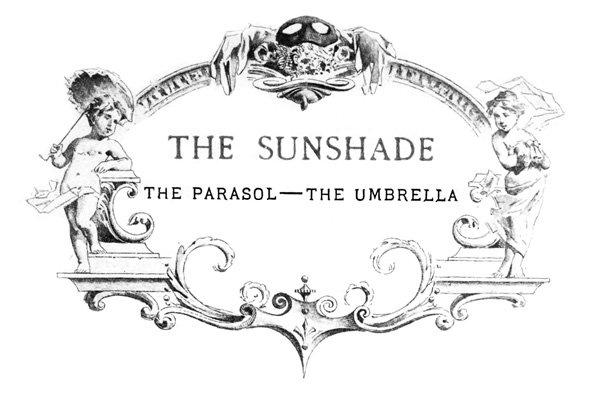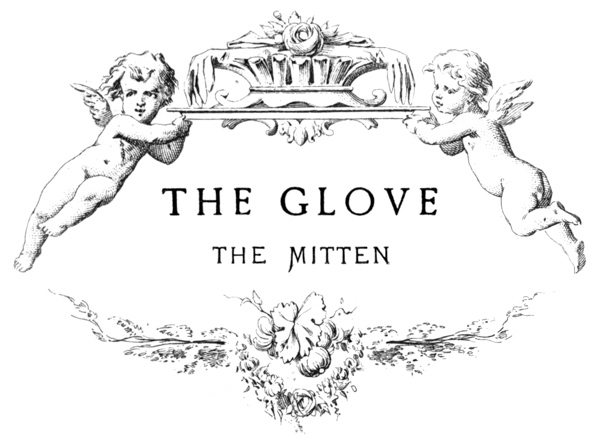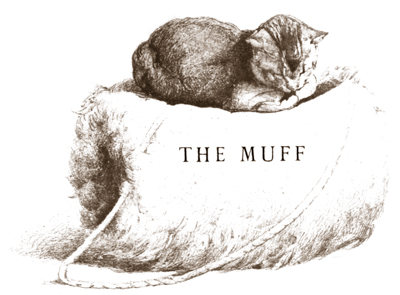.

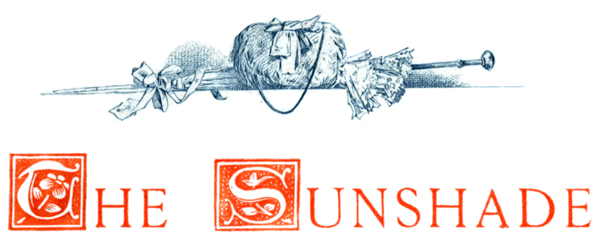
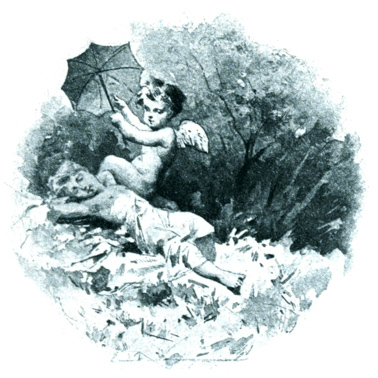
J. C. NIMMO AND BAIN
14, KING WILLIAM STREET, STRAND, W.C.
1883
PREFACE
 AFTER the brilliant success which attended, in the spring of last year, our volume on The Fan—a success which was the result, as I cannot conceal from myself, much more of the original conception and decorative execution of that work of luxe than of its literary interest—I have determined to close this series of Woman’s Ornaments by a last little work on the protective adornments of that delicate being, as graceful as she is gracious: The Sunshade, the Glove, the Muff. This collection, therefore, of feminine toys will be limited to two volumes, a collection which at first sight appeared to us so complex and heavy that a dozen volumes at least would have been required to contain its principal elements. This, doubtless, on the one hand, would have tried our own constancy, and on the other, would have failed in fixing more surely the inconstancy of our female readers. The spirit has its freaks of independence, and the unforeseen of life ought to be carefully economised. Moreover, to tell the whole truth, the decorative elegance of a book like the present hides very often beneath its prints the torture of an intellectual thumbscrew. The unhappy author is obliged to confine his exuberant ideas in a sort of strait-jacket in order to slip them more easily through the varied combinations of pictorial design, which here rules, an inexorable Mentor, over the text.
AFTER the brilliant success which attended, in the spring of last year, our volume on The Fan—a success which was the result, as I cannot conceal from myself, much more of the original conception and decorative execution of that work of luxe than of its literary interest—I have determined to close this series of Woman’s Ornaments by a last little work on the protective adornments of that delicate being, as graceful as she is gracious: The Sunshade, the Glove, the Muff. This collection, therefore, of feminine toys will be limited to two volumes, a collection which at first sight appeared to us so complex and heavy that a dozen volumes at least would have been required to contain its principal elements. This, doubtless, on the one hand, would have tried our own constancy, and on the other, would have failed in fixing more surely the inconstancy of our female readers. The spirit has its freaks of independence, and the unforeseen of life ought to be carefully economised. Moreover, to tell the whole truth, the decorative elegance of a book like the present hides very often beneath its prints the torture of an intellectual thumbscrew. The unhappy author is obliged to confine his exuberant ideas in a sort of strait-jacket in order to slip them more easily through the varied combinations of pictorial design, which here rules, an inexorable Mentor, over the text.
In a work printed in this manner, just as in a theatre, the mise en scène is often detrimental to the piece; the one murders the other—it cannot be otherwise—the public applauds, but the writer who has the worship of his art sorrowfully resigns himself, and inwardly protests against the condescension of which he has had experience.
Two volumes, then, under a form which thus imprisons the strolling, sauntering, inventive, and paradoxical spirit, will be sufficient for my lady readers. Very soon we shall meet again in books with vaster horizons, and “ceilings not so low,” to employ an expression which well describes the moral imprisonment in which I am enveloped by the graces and exquisite talent of my collaborateur, Paul Avril.
Let it be understood, then, that I have no personal literary pretensions in this work. As the sage Montaigne says in his Essays, “I have here but collected a heap of foreign flowers, and brought of my own only the string which binds them together.”
Octave Uzanne.
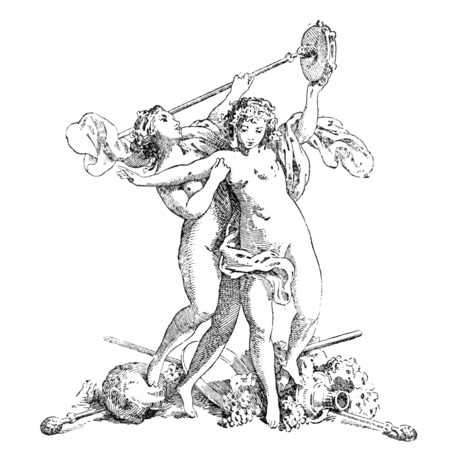
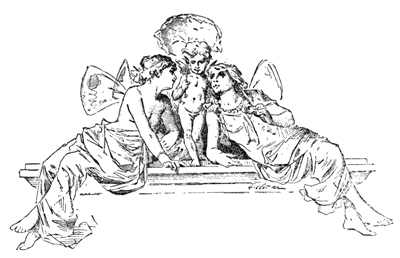
THE SUNSHADE
THE PARASOL —— THE UMBRELLA
 THE author of a Dictionary of Inventions, after having proved the use of the Parasol in France about 1680, openly gives up any attempt to determine its precise original conception, which indeed seems to be completely concealed in the night of time.
THE author of a Dictionary of Inventions, after having proved the use of the Parasol in France about 1680, openly gives up any attempt to determine its precise original conception, which indeed seems to be completely concealed in the night of time.
It would evidently be childish to attempt to assign a date to the invention of Parasols; it would be better to go back to Genesis at once. A biblical expression, the shelter which defends from the sun, would almost suffice to demonstrate the Oriental origin of the Parasol, if it did not appear everywhere in the most remote antiquity—as well in the Nineveh sculptures, discovered and described by M. Layard; as on the bas-reliefs of the palaces or frescoes of the tombs of Thebes and Memphis.
In China they used the Parasol more than two thousand years before Christ. There is mention of it in the Thong-sou-wen, under the denomination of San-Kaï, in the time of the first dynasties, and a Chinese legend attributes the invention of it to the wife of Lou-pan, a celebrated carpenter of antiquity. “Sir,” said this incomparable spouse to her husband, “you make with extreme cleverness houses for men, but it is impossible to make them move, whilst the object which I am framing for their private use can be carried to any distance, beyond even a thousand leagues.”
And Lou-pan, stupefied by his wife’s genius, then saw the unfolding of the first Parasol.
Interesting as these legends may be, handed down by tradition to the peoples of the East, they have no more historical credit than our delicate fables of mythology: they preserve in themselves less of the poetic quintessence, and above all seem less connected with that mysterious charm with which Greek paganism drowned that charming Olympus wherefrom the very origins of art appear to descend.
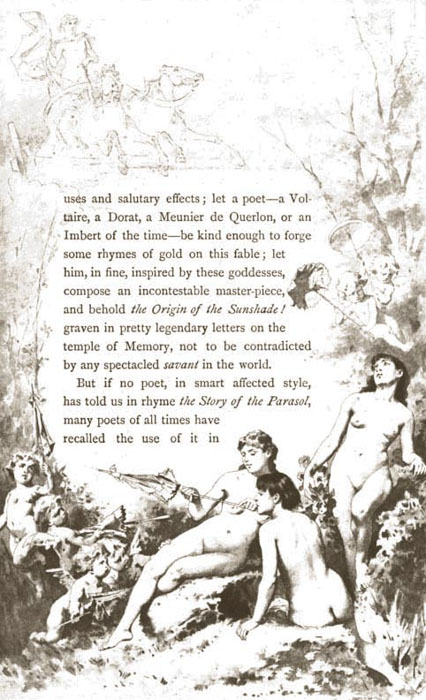
Let the three Graces be represented burned by Apollo, tired of flying through the shadows, where Fauns and Ægipans lie in ambush, or let these three fair ones be painted in despair at the fiery sensation of sunburning which brands their epidermis; let them invoke Venus, and let the Loves appear immediately, bearers of unknown instruments, busily occupied in working the little hidden springs, ingeniously showing their different uses and salutary effects; let a poet—a Voltaire, a Dorat, a Meunier de Querlon, or an Imbert of the time—be kind enough to forge some rhymes of gold on this fable; let him, in fine, inspired by these goddesses, compose an incontestable master-piece, and behold the Origin of the Sunshade! graven in pretty legendary letters on the temple of Memory, not to be contradicted by any spectacled savant in the world.
But if no poet, in smart affected style, has told us in rhyme the Story of the Parasol, many poets of all times have recalled the use of it in precious verses, which appear to serve as landmarks for history, and as references to discoveries of archæology. In ancient Greece, in the time of the festivals of Bacchus, it was the custom, not then confounded with fashion, to carry a Sunshade, not so much to extenuate the ardour of the sun, but as a sort of religious ceremonial. Paciaudi, in his treatise De Umbellæ Gestatione, shows us on the carriage on which the statue of Bacchus is placed a youth seated, the bearer of a Sunshade, a sign of divine majesty. Pausanias, in his Arcadics, mentions the Sunshade in describing the festivals of Alea in Argolis, whilst later on, in the Eleutheria, we see the Parasol also. Lastly, after having painted for us, in a marvellous description of Alexandria on a holiday, the hierophants, bearers of emblems and the mystic vase, the Monads covered with ivy, the Bassarids with scattered hair wielding their thyrsus, Athenæus suddenly shows us the magnificent chariot of Bacchus, where the statue of the god, six cubits high, all in gold, with a purple robe falling to his heels, had over his head a Sunshade ornamented with gold. Bacchus alone, of all the gods, had the privilege of the Sunshade, if we rely on the evidence of ancient monuments, earthen vases, and graven stones drawn from the museums of Stosch and other archæologists.
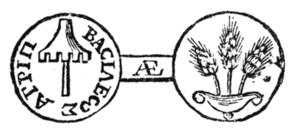
As a result of their frequent relations with the Greeks after the death of Alexander the Great, the Jews appear to have borrowed from the Gentiles, in the celebration of their Feast of Tabernacles, the use of the Sunshade. The subjoined medal of Agrippa the Old, struck by the Hellenised Jews, in some sort supports this, although Spanheim, in a passage relating to this medal, says he has hesitated a long while as to the signification of the symbols which it represents. Do the ears of corn mark the fertility of the governed provinces, or do they refer to the Feast of Tabernacles? As for the tent on the obverse, it is little probable that it represents a tabernacle according to Moses’ rite, since the roofs of these tabernacles, far from being pointed, were flat and cloven in the midst, so as to allow rain, sun, and starlight to pass through. It must then be the Sunshade, the emblem of royalty; this at least seems probable.
The Parasol played among the Greeks a very important part, as well in the sacred and funeral ceremonies as in the great holidays of nature, and even in the private life of the noble ladies of Athens.
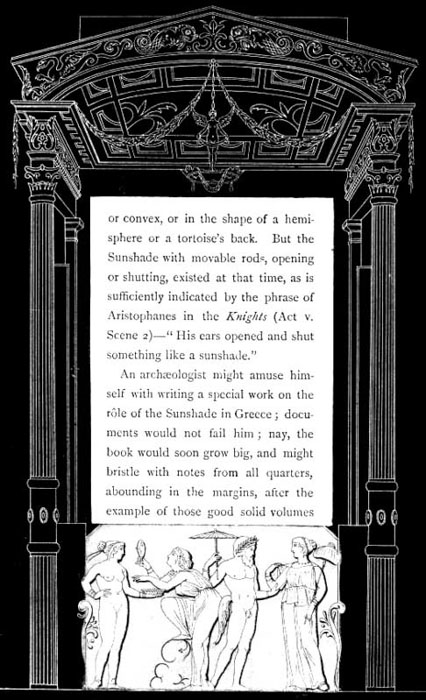
The Parasol in its elegant form may be seen drawn on the majority of Greek vases, either painted with straight or arched branches, concave or convex, or in the shape of a hemisphere or a tortoise’s back. But the Sunshade with movable rods, opening or shutting, existed at that time, as is sufficiently indicated by the phrase of Aristophanes in the Knights (Act v. Scene 2)—“His ears opened and shut something like a sunshade.”
An archæologist might amuse himself with writing a special work on the rôle of the Sunshade in Greece; documents would not fail him; nay, the book would soon grow big, and might bristle with notes from all quarters, abounding in the margins, after the example of those good solid volumes of the sixteenth century, which none but a hermit would have the leisure to read conscientiously to-day. Such is not our business in this light chapter.
One cannot exactly say for what motive the Sunshade was carried by young virgins in all the processions in the Thesmophoria, the festivals of Eleusis, and the Panathenæa. Aristophanes calls the baskets and the white Sunshades “symbolic instruments, destined to recall to human beings the acts of Ceres and Proserpine.”
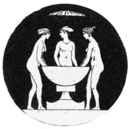
Perhaps it is not necessary to search beyond this Aristophanic definition, which may on the whole entirely satisfy us. Moreover, these Sunshades were white, not, say they, because the statue erected by Theseus to Minerva was of that colour, but because white marked the liveliest joy and pomp according to Ovid, who recommends very carefully in his Fasti the wearing in sign of rejoicings white tunics worthy of pleasing Ceres, in whose cult both the priestesses and the things they used ought to be entirely white.
In a man, according to Anacreon, the carrying a Parasol was the mark of a libertine and effeminate life; one might draw an analogous conclusion from a scene in the Birds of Aristophanes, in which Prometheus, through fear of Jupiter, cries to his slave, before abandoning himself to a sweet passion for Venus only, “Quick, take this sunshade, and hold it over me, in order that the gods may not see me.”
It is also doubtless for the same reason, which virtually interdicted the use of the Parasol to men, that the daughters of the Metœci, or strangers domiciled at Athens, carried, according to Ælian, the sunshade of the Athenian women in the spectacles and public ceremonies, whilst the fathers carried the vases destined for the sacrifices.
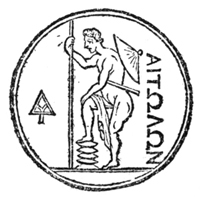
The Θολἱα, or “Sunshade Hat,” succeeded the Parasol properly so called. It is of these Θολἱα that Theocritus speaks in several places; it is also this hat, and not a Sunshade, which we must see in the curious medal above, stamped by the Ætolians, which represents Apollo bearing this strange hat, in the style of Yokohama, hanging on his back.
From the most distant epochs the Sunshade has been considered, so far as it is the attribute of gods and sovereigns, as the ensign of omnipotence. We see it playing this supreme rôle, not only by right of an emblem of blazonry, in the curious dissertation of the Chevalier Beatianus On a Sunshade of vermeil on a field argent, symbol of power, sovereign authority and true friendship, but also we see it universally adopted as a sign of the highest distinction by Oriental peoples, to be displayed over the head of the king in time of peace, and occasionally in time of war.
It is thus that it may be contemplated on the sculptures of ancient Egypt, where its usage was not exclusively indeed reserved to the Pharaohs, but sometimes also to the great dignitaries, but to these only. There is to be seen in Wilkinson a strange engraving representing an Æthiopian princess seated on a plaustrum or carriage drawn by oxen, and having behind her a vague personage armed with a large Parasol of an undecided form, something between the screen and the flabellum in the segment of a circle. Is it not also in sign of adoration that it was the custom to put above the heads of divine statues crescents, Sunshades, little spheres, which served not only to guarantee these august heads against the injuries of time and the ordures of birds, but also to set their physiognomy in relief as by a nimbus or crown of paganism?

The kings or satraps of Persia of the oldest dynasties were sheltered by the sovereign Parasol. Chardin, in his Voyages, describes bas-reliefs of a time long before that of Alexander the Great, in which the king of Persia is frequently represented sometimes just about to mount his horse, at others surrounded by young slave-girls—beautiful as day, as a poet might write for sake of a simile—among whom one inclines a Sunshade, while another uses a flyflap made of a horse’s silky tail. Other bas-reliefs, again, represent the Persian monarch on a throne, at the conclusion of a victorious battle, whilst the rebels are being crucified, and writhe under the punishment, and prisoners brought up, one after the other, make humble submission. Here the Sunshade has the floating appearance of a glorious standard. It symbolised also the power of life and death, vested in the savage conqueror over the unfortunate conquered, delivered up wholly to his mercy.
In ancient India, the cradle of the human race, as it is said, the Parasol in every time, and more than anywhere else, is unfolded in its splendour and the grace of its contexture, as an immutable symbol of royal majesty. It seems really that it was under the deep azure of the admirable Indian sky that the coquettish instrument, of which we are exposing here by literary zigzags the historic summary, was invented. It must have been born there first as a fragile buckler to oppose the ardour of the sun; afterwards, doubtless, it developed, little by little, into a large dome, carried in the arms of slaves, or on the back of an elephant, showing the sparkle of its colours, the originality of its form, the richness of its tissues, all overloaded with fine gold and silver filigree, making its spangles and jewels scintillate in the full leaping light, in the slow oscillation given to it by the march of its bearers, or the swayings of a heavy pachyderm, in the midst of magic powers, of dancers and enchantments without number among the most bizarre palaces of the world.
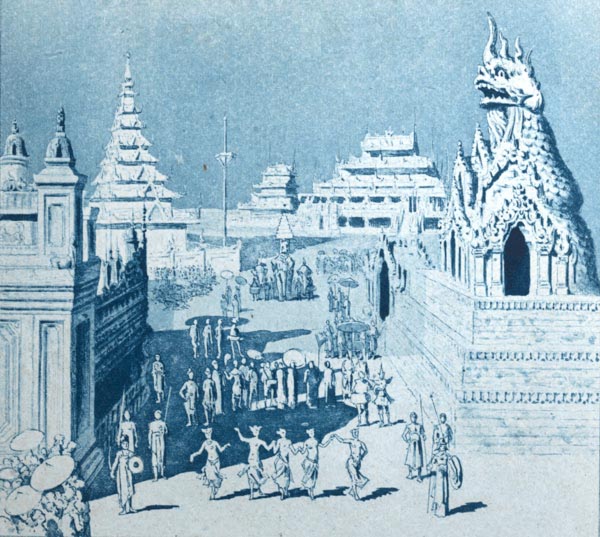
In Hindostan the large Parasol is commonly called Tch’hâtâ, the small ordinary Parasol Tch’hâtry, and the bearer of the Parasol for dignitaries tch’hâtâ-wâlâ.
The Parasol of seven stages (savetraxat) is the first ensign of royalty: it is found graven on the royal seal. The mythology and literature of the Hindoos are, so to speak, confusedly peopled with Parasols. In his fifth incarnation, Vishnu descends to Hades with a Parasol in his hand. On the other hand, from the seventh century, Hiouen Thsang has remarked, according to the rites of the kingdom of Kapitha, Brâhma and Indra were represented holding in their hand, one a flyflap, the other a Parasol. In the Râmayana (ch. xxvi. scloka 12), Sitâ, speaking of Râma, whose beautiful eyes resemble the petals of the lotus, expresses herself thus—“Covered with the Parasol striped with a hundred rays, and such as the entire orb of the moon, why do I not see thy most charming face shining beneath it?”
We read also in the Mahâbârata (sclokas 4941-4943)—“The litter on which was placed the inanimate body of the monarch Pândou was adorned with a flyflap, a fan, and a white Sunshade; at the sound of all the instruments of music, men by hundreds offered, in honour of the extinguished shoot of Kourou, a crowd of flyflaps, white Sunshades, and splendid robes.”
The Mahratta princes who reigned in Punah and Sattara held the title of Tch’hâtâ pati, “Lord of the Parasol;” and we are told that one of the most esteemed titles of the monarch of Ava was also that of “King of the White Elephant, and Lord of the Four-and-twenty Parasols.”
When, in 1877, the Prince of Wales, future inheritor of the throne of England, undertook his famous voyage into India, it was absolutely necessary—says Dr. W. H. Russell, the scrupulous historian of that princely expedition—in order to make him known to the natives, to set the Prince upon an elephant, and to hold over his head the golden Sunshade, symbol of his sovereignty.
There may be seen to-day in the South Kensington Museum, in the admirable Indian gallery which has just been installed, some score of the Parasols brought back by the Prince from his voyage, of which each particular type deserves a description which cannot, alas! to our sincere regret, find its place here. One may admire there the state Umbrella of Indore, in the form of a mushroom; the Sunshade of the Queen of Lucknow, in blue satin stitched with gold and covered with fine pearls; next the Parasols of gilt paper, others woven of different materials, some entirely covered with ravishing feathers of rare birds, all with long handles in gold or silver, damascened, in painted wood, in carved ivory, of a richness and an execution not to be forgotten.
Let us tear ourselves away, as in duty bound, from Hindustan, to meet again with the Parasol on more classic ground in ancient Rome, in the middle of the Forum and of the games of the Circus. The Sunshade is found very frequently in the most ancient paintings, on stones and vases of Etruria, a long while even before the Roman era. According to Pliny and Valerius Maximus, it is from Campania that the Velarium comes, which is destined to defend the spectators from the sun. The use of the private Sunshade for each person established itself by degrees on those days when, on account of the wind, the Velarium could not be used. Martial says in his Epigrams (Book IV.):
Accipe quæ nimios vincant umbracula soles
Sit licet et ventus, te tua vela tegent.
People used the Sunshade not only at theatres, but also at battles, and above all in the promenade. Ovid, in his Fasti, shows us Hercules protecting his well-beloved Omphale by means of a Sunshade from the sun’s rays:
Aurea pellebant tepidos umbracula soles
Quæ tamen Herculeæ sustinuere manus.
This image of Hercules carrying a light Parasol would surely be worthy to replace the used-up theme of the distaff?
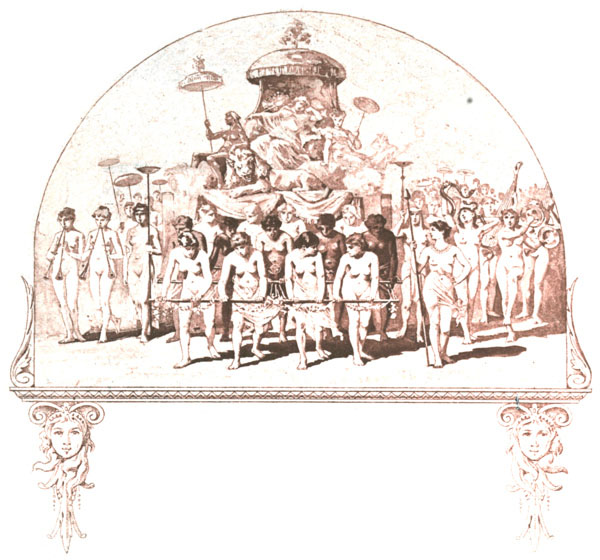
The ancient Romans brought to the decoration of their Parasols a magnificence unknown in our days. They borrowed from the East its stuffs, its jewels, its ornamental style, to enrich in the best manner possible these pretty portable tents. When Heliogabalus, forgetting his sex, after the example of the priests of Atys, appeared on his car clothed with the long dress and all the gewgaws that women wear; when he caused himself to be drawn along surrounded by legions of nude slave-girls, he carried a fan in the guise of a sceptre; and not only was there a golden Parasol in the form of a dais stretched over his head, but also at each side two umbelliferæ held light Sunshades of silk, covered with diamonds, mounted on Indian bamboo, or on a stem of gold carved and encrusted with the most wondrous jewels.
In the train which accompanied a matron on the Appian Way, if we can believe the historian of Rome in the age of Augustus, two slaves were obligatory: the fan-bearer (flabellifera) and the follower (pedis sequa). The latter carried an elegant Parasol of linen stretched over light rods at the extremity of a very long reed, so that, at the least sign of her mistress, she might direct over her the shadow of this movable defence.
The Roman Umbrella seems to have been nothing but a simple morsel of leather, according to these verses, which Martial wrote by way of advice:
Ingrediare viam cœlo licet usque sereno;
Ad subitas nunquam scortea desit aquas.
This “leather cloth” was assuredly an Umbrella, which, except perhaps in weight, need have envied nothing of our own.
At Rome, as at Athens, the Sunshade appears to have hidden people from the looks of the gods, for, according to Montfauçon, even the Triclinia were covered with a sort of Sunshade, that folk might deliver themselves more mysteriously to orgies of every kind and to the pleasures of Venus.
The material used in the manufacture of Sunshades was originally, according to Pliny, leaves of palm divided into two, or the tresses of the osier; afterwards they were made in silk, in purple, in Eastern stuffs, in gold, in silver; they were adorned with Indian ivory; they were starred with trinkets and jewels. One author tells us even of Sunshades made out of women’s hair—the hair of women so arranged as to supply the place of a Sunshade.
Singular headdress or singular Parasol!
Juvenal speaks of a green Sunshade sent with some yellow amber to a friend to celebrate her birthday and the return of spring.
En cui tu viridem umbellam, cui succina mittas
Grandia, natalis quoties redit, aut madidum ver Incipit.
And with regard to this green Sunshade, apropos of the viridem, all the commentators enter into the field, and make a deafening noise to explain that the epithet had no reference to the colour of the Sunshade, but to the spring.
Let us, if you please, leave Rome, without entering into these idle dissertations.
It would be difficult for us to find in the Middle Ages numerous manifestations of the Sunshade in private life; it was evidently adopted in the ceremonies of the Christian Church and in the royal entrées; but it was especially the privilege of the great, and never appeared save on solemn days in the processions, as later on the dais, reserved for kings and ecclesiastical nobles.
At Venice the Doge had already his celebrated Sunshade in 1176. The Pope Alexander III. had accorded to the Venetian chiefs the right to carry the Sunshade in the processions. Under the reign of the Doge Giovanni Dandolo (1288) it was ordered that the pretty golden statuette of the Annunciation should be added, which is seen represented at the top of the Sunshade of the Venetian dogate.
One can get some idea of this marvellous Sunshade, all of gold brocade, and of a pompous and original shape, by looking at most of the prints of the time, and particularly at the celebrated engraving of the Procession of the Doge, as well as at the pictures of Canaletto, Francesco Guardi, Tiepolo, and the greater number of the charming Venetian painters of the eighteenth century.
It seems evident that the Roman Gauls knew the use of the Parasol, but it would not be easy to demonstrate its existence logically in the martial and Gothic epochs. One can scarcely imagine these men of arms, these gentle pages, and these noble damsels, with their lofty head-gear and long dress, defended by a frail silken encas (in case). They feared not then assuredly either sun or rain; they dreamed of nought but batailloles (little battles), according to the language of that day; everything was done in honour of the ladies, after the laws of the good King René, and the ladies would certainly never have wished at the hour of the glorious tournaments to shelter themselves at the approaches of the lists, against a sun which sparkled on the breastplate of their brave knights with as much brightness as the hope which shone in their eyes.


Let us come now to China, to find there Parasols and Umbrellas in great honour, since the beginning of the dynasty Tchéou (eleventh century before Christ).
“The Umbrellas of that time,” says M. Natalis Rondot, “resembled ours; the mounting was composed of twenty-eight curved branches, and covered with silken stuff. The Parasols were of feathers.
“After the Thong-ya, it is only under the first Wei (A.D. 220-264) that gentlemen began the use of Parasols; these Parasols were most frequently made of little rods of bamboo and oiled paper; pedestrians never made use of them before the second Wei (386-554). Parasols figure ordinarily in processions and funerals since the seventh century. Thus, in 648, at the time of the inauguration of the Convent of the Grand Beneficence, at Si-ngan-Fou, one counted—says the historian of the Life of Hiouen thsang—only in the procession three hundred Parasols of precious stuffs. The Parasol in China, as in India, has always been a sign of elevated rank, although it has not been exclusively used by emperors and mandarins. Formerly, it seems, four-and-twenty Parasols were carried before the Emperor when his Majesty went to the chase.
“A Chinese of a rank at all elevated, such as a mandarin, a bonze, or a priest, never goes out without a Parasol,” according to M. Marie Cazal, a Sunshade manufacturer, who, about the year 1844, wrote a small Essay on the Umbrella, the Walking-stick, and their Manufacture.—‘Every Chinese of a superior order is followed by his slave, who carries his Parasol extended over him.’
“The Umbrella in China is destined to the same use as the Parasol, says M. Cazal: it belongs to all. Never, when the weather is the least degree doubtful, does a Chinese go out of doors without his Umbrella. Even horses are sheltered, as well as elephants, by Parasols or Umbrellas fastened to branches of bamboo. Their drivers take very good care not to illtreat them; imbued as they are, like every good Chinaman, with the doctrines of metempsychosis, they fear to torture the soul of their father or their grandfather, reduced, in order to expiate his faults, to animate the body of these quadrupeds.”
The Umbrellas and Parasols which are most common in China resemble very much those which are imported into Europe; they are made entirely of stalks of bamboo, disposed with enormous art, and covered with oiled, tarred, or lacquered paper. Some are coloured, and have printed on them religious allegories or sentences of Confucius.
All the voyages in China and around the world are filled with details of the Chinese Parasol. “The Chinese women, whose feet have been compressed from infancy,” remarks M. Charles Lavollée, “can scarcely walk, and are obliged to support themselves on the handle of their Parasol, which serves them for a walking-stick.”
The Parasol and the Fan in China play a rôle so considerable, that it would be necessary to write a special monograph on each of these two objects in order to consider properly their importance in the history of the country and its current manners. In a general and summary sketch like the present, must we not skim through, rather than sew together documents collected with difficulty, or found within reach, and leave aside the more bulky bundles, under pain of foundering in the folio form of heavy dictionaries?
Everywhere on the exquisite decorative combinations of Japan, we see a large Parasol opened amidst delicate peach-blossoms, gracious flights of strange birds, indented leaves, and rosy ibises. Sometimes, on the inimitable paintings of the enamelled vases, the Japanese Sunshade shelters a king’s daughter, escorted by her followers, who makes her chaste preparations for entering the bath; sometimes, on a thin gauze, the Parasol half hides women, promenading on the margin of some vast blue lake, full of ideal dreams. Sometimes, in fine, in a fantastic sketch of an album, which one reads as a riot of the imagination, is perceived some human being excited to a singular degree, with hair tossed by the wind, and haggard eye, floating at the will of the tumultuous waves on a Parasol turned upside down, to the handle of which he clings with the energy of despair. The plates of the Voyage de Ricord, and especially the old Japanese albums, are useful to consult in order to understand better the varieties of forms of the Sunshade in Japan. We gain a bizarre notion of the effects and services which a Japanese can obtain from a common Parasol of his country by looking at the games of the acrobats who come to us occasionally from Tokio, Yedo, or Yokohama. Théophile Gautier, who was highly astonished, and not without reason, at the quickness, grace, and daring of these marvellous equilibrists, has left us on this matter the fairest pages, perhaps, of his Feuilletons de Lundiste. The worthy Théo, that Gallic Rajah borrowed from these clowns, astonishing in their lightness, an enthusiasm which put on his palette as a colourist the most vibrating tones and the finest shades. The Sunshade and the Fan are in fact presented by these magicians of the East with particular graces in the jugglery of the most varied exercises. Here it is a ball of ivory which rolls with the bickering of a babbling stream over the lamels or ribs of the Sunshade; there it is a Parasol held in equilibrium on the blade of a dagger, and a thousand other astonishing inventions. All these fascinating feats of skill cannot be described save in the manner of Gautier, in other words, by veritable pen-pictures. Admirable interpretation of things glimpsed at!
In the tea-houses of Tokio, the pretty Geishas often employ, to mimic an expressive dance, the Fan and the little paper Parasol.
One of the most usual of their dances, managed something like our ballets, is called the Rain-dance. This is the way in which a Globe-trotter gives an account of its leading idea and character:—
“Some young girls prepare to leave their homes, and to pose as beauties in the streets of Yedo. They admire each other in playing their fans, they are dressed in superb toilets—they are sure of turning the heads of all the young samouraï of the town.
“Scarcely have they got out of doors when a thick cloud appears. Great disquietude! They open their Parasol, and make a thousand pretty grimaces, to show how sadly they fear the ruin of their charming dresses. . . . A few drops of rain begin to fall: they quicken their steps on their way home again.
“A burst of thunder occasioned by the Samisen and the drums, is heard, which announces a terrible downpour. Then our four dancers catch their robes with both hands, and throw them with one sweep under their arms, and suddenly turning, take to their heels, showing us a row of little . . . . frightened faces, saving themselves at the full speed of their legs.”
What a series of pantomimes, in which the Sunshade must assume in the hands of the charming Geishas the most seductive positions!
“Among the Arabs the Parasol was a mark of distinction” (as we learn from M. O. S., the English reporter of a commission which published a small notice on Umbrellas, Parasols, and Walking-sticks in London about 1871). There is the same importance attached to it among certain blacks of Western Africa, who have probably borrowed it from the Arabs. Niebuhr, in the description of the procession of the Imam of Sanah, tells us that the Imam, and every one of the princes of his numerous family, had carried by their side a Madalla or large Parasol. It is in that country a privilege of princes of the blood. The same writer relates that many independent chiefs of Yemen bear Madallas as a mark of their independence. In Morocco the Emperor alone and his family have the privilege of the Parasol. In the Voyages of Aly Bey we read in fact:—“The retinue of the Sultan was composed of a troop of from fifteen to twenty gentlemen as the vanguard; behind them, some hundred paces, came the Sultan, mounted on a mule, having beside him, also mounted on a mule, an officer carrying the Imperial Parasol. The Parasol is the distinctive sign of the sovereign of Morocco. No one but he would dare to use it.”
In certain tribes of central Africa explorers speak of having encountered, amidst the tribes of the desert, kings half-dressed in European old clothes, taken or exchanged no one knows where; and, strangely enough, on the top of an old silk hat, half-knocked in, one of these negro kings, says a traveller, held with a sort of grotesque majesty an old torn Umbrella of which the whalebone appeared to be half-broken. This Robert Macaire of the desert, does he not recall that pleasant equatorial fantasy of the Parnassiculet Contemporain, a sonnet terminating with the verses:—
What then is strange about this desert’s pride,
Who in the desert without thee had died?
Bétani answered, “Child of open mien,
Where on board ship he comes, I tell you that
For full court-dress, this half-blood wears a hat
Of an old shako, trimmed with tufts of green!”
This fantasy might serve as a theme for a dissertation on the subject, “Whither do worn-out things go?—what becomes of the old umbrellas?” It would be a ballad full of colour for a Villon of the present time.
To return to France, many writers, romancists or dramatic authors, having greater care of the splendour of the mise-en-scène than of absolute historic truth, have presented us with some hunting parties of the time of Henri II. and Henri III., in which the noble huntresses followed the deer on horses magnificently harnessed, holding in their hands hexagonal Sunshades fringed with gold and enriched with pearls.
We found truly a mention of the Parasol in the Description of the Isle of the Hermaphrodites; but it was then very rare in France, and what is more, very heavy, and handled with such ceremonies that a strong lackey must have had considerable difficulty in holding it up. From this to place light Sunshades of silk between the dainty fingers of “fair and gentle dames” of that time, especially for a hunt through the woods, there is, it seems to us, a departure which good sense alone, not to mention historic science, is quite enough to point out.
The Parasol was still very little known in France, even in the second half of the sixteenth century. It is fairly certain that, like the Fan, and other objects so much in favour with Catherine de Medici, it was brought into France out of Italy. Henri Estienne, in his Dialogues of the new French Language Italianised, 1578, makes one of his interlocutors called Celtophile say: “ . . . . and à propos of pavilion, have you ever seen what some of the lords in Spain or Italy carry or cause to be carried about in the country, to defend themselves, not so much from the flies, as from the sun? It is supported by a stick, and so made that being folded up and occupying very little space, it can when necessary be opened immediately and stretched out in a circle so as to cover three or four persons.” And Philausone answers: “I have never seen one; but I have heard talk of them often; and if our ladies were to see them carrying these things, they would perhaps tax them with too great delicacy.”
In Italy it is little probable that since the Romans the inhabitants of the higher classes have ever unlearned the pleasant use of Parasols. The majority of travellers notice them in all epochs, and in the Italian Mysteries, played in the fourteenth and fifteenth centuries, it is nearly certain that at the moment of their naïve representation of the Deluge, the Deity appeared on the stage with an Umbrella in his hand.
In the Journal and Voyage of Montaigne in Italy, the good philosopher, who teaches us so few matters beyond his own personal sufferings, deigns, nevertheless, to aver that the supreme good taste of the women of Lucca was to have incessantly a Parasol in their hands.
“No season,” says also elsewhere this charming epicurean essayist, “is so much my enemy as the sharp heat of sunshine, for the Sunshades, which are used in Italy since the time of the ancient Romans, charge the arms more than they discharge from the head.”
So, too, Thomas Coryat, an English tourist of that time, in his Crudities (1611), speaks of the Italian Parasols, after having noticed the presence of Fans in the towns through which he had travelled: “Many Italians,” he says, “do carry other fine things of a far greater price, that will cost at the least a ducat (about seven francs), which they commonly call in the Italian tongue Umbrellæs, that is, things that minister shadow unto them for shelter against the scorching heat of the sun. These are made of leather, something answerable to the form of a little canopy, and hooped in the inside with divers little wooden hoops, that extend the Umbrella in a pretty large compass. They are used especially by horsemen, who carry them in their hands when they ride, fastening the end of the handle upon one of their thighs, and they impart so large a shadow unto them that it keepeth the heat of the sun from the upper parts of their body.”
Fabri, in his useful and remarkable work, Diversarum Nationum Ornatus (additio) confirms this fact from 1593, in taking care to represent a noble Italian, travelling on horseback with a Parasol in his hand: “Nobilis Italus ruri ambulans tempore æstatis.”
What variety this simple detail, more propagated or rather better vulgarised among our romancists, would have thrown into the great romances of adventure! We should have seen the protecting Sunshade marking from a distance, by its colour and elevated shape, the presence of the rich traveller to be robbed, in the mountains of Tuscany, while the brigands of the time kept their watch in the folds of the rocks; then, too, we should surely have witnessed, in passionate recitals of heroic combats, the buckler Parasol, already full of holes, torn into shreds, yet still serving to parry victoriously the blows of the ferocious cut-throats and cloak-snatchers.
And how many sonorous and unforeseen titles are there of which we have been deprived by this fact of our ignorance: The Knights of the Sunshade—The Heroic Parasol—The State Courier, or the Sunshade Recovered! . . . . and who can say how many more!

The Arsenal, the old Hotel de Sully, preserved for a long time one of those Parasols, which librarians named the Pepin (seed-fruit) of Henri IV. It was very big, and entirely covered with blue silk, with long and distinctly precious flowers of the golden lily scattered over it. This Parasol, ministerial or royal, is doubtless lost, and we speak of it only after the description which the learned bibliophile Jacob has given us.
Daniel Defoe, who published his Robinson Crusoe in 1719, was one of the first to mention to any extent the Parasol in England. Before him, as we shall see farther on, it had been named only very summarily in literary works. So firmly fixed in our imaginations as men, the children of yesterday, is the great Umbrella of Crusoe, and his dreadful alarm on seeing the print of a man’s foot on the shore, as well as his walks with his dog and Friday the good Caribbee; it presents itself, moreover, so clearly in our first literary remembrances, that we will reproduce the passage of the journal where it is mentioned:
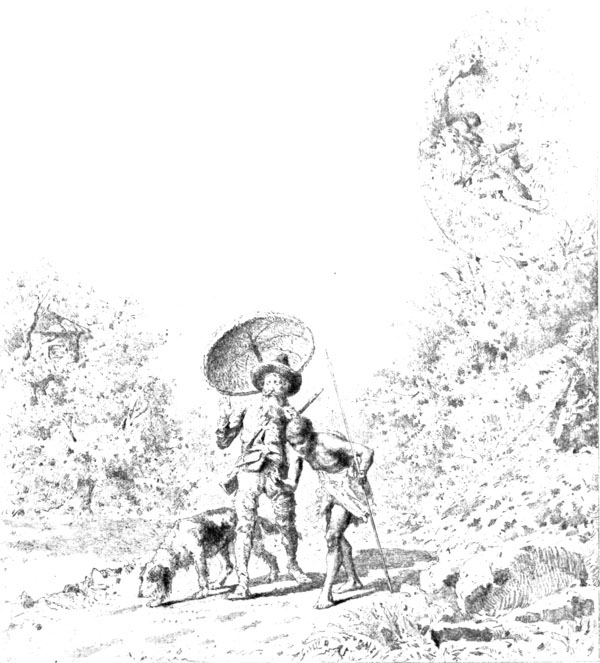
“After this,” says Crusoe, “I spent a deal of time and pains to make me an Umbrella. I was indeed in great want of one, and had a great mind to make one. I had seen them made in the Brazils, where they are very useful in the great heats which are there; and I felt the heats every jot as great here, and greater too...; besides, as I was obliged to be much abroad, it was a most useful thing to me, as well for the rains as the heats. I took a world of pains at it, and was a great while before I could make anything likely to hold; nay, after I thought I had hit the way, I spoiled two or three before I made one to my mind; but at last I made one that answered indifferently well; the main difficulty, I found, was to make it to let down: I could make it to spread, but if it did not let down too, and draw in, it would not be portable for me any way, but just over my head, which would not do. However, at last, as I said, I made one to answer; I covered it with skins, the hair upward, so that it cast off the rain like a pent-house, and kept off the sun so effectually, that I could walk out in the hottest of the weather, with greater advantage than I could before in the coolest; and when I had no need of it, I could close it and carry it under my arm.”
And this Parasol, for a century and a half, has been popularised by the engraver, with its dome of hair and rude manufacture; and so all the poor little prisoners at school invoke it, and dream often that they carry it in some desert isle, for it represents to their eyes a life of open air and liberty.
Before Daniel Defoe, Ben Jonson had already mentioned the Parasol in England in a comedy played in 1616; and Drayton, sending some doves to his mistress in 1620—a delicious lover’s fancy—formulated in his passioned verses the following desire: “May they, these white turtle doves I send you, shelter you like Parasols under their wings in every sort of weather.”
In the relation of his Voyage in France in 1675, Locke, speaking of Sunshades, says: “These are little articles and very light, which women use here, to defend themselves from the sun, and they seem to us very convenient.” Afterwards the English ladies desired to possess these pretty Parasols, although, by reason of their climate, such things could hardly be of any use to them. It was not, however, till the eighteenth century that a London manufacturer bethought himself of inventing the Sunshade-Fan, compared with which it appears the French folding marquises were as nothing. This ingenious fabricator made a considerable fortune; but if we are to believe the Improvisateur François, his invention was rapidly imitated and much improved in Paris. Why has it not been preserved to our own days?
But let us linger in this seventeenth century, and remain awhile in France, where the Parasol was not in use, save at court among the great ladies. Men never used it to shelter themselves from the rain—the cloak and sword were still alone in fashion.
Ménage tells us in his Ménagiana, that being with M. de Beautru, about 1685, in the midst of a pouring rain at the door of the Hôtel de Bourgogne, up came a Gascon gentleman, without a cloak, and nearly wet through; the Gascon, seeing himself stared at, cried out, “I would lay a wager now my people have forgotten to give me my cloak.” To which M. de Beautru quickly replied, “I go halves with you.”
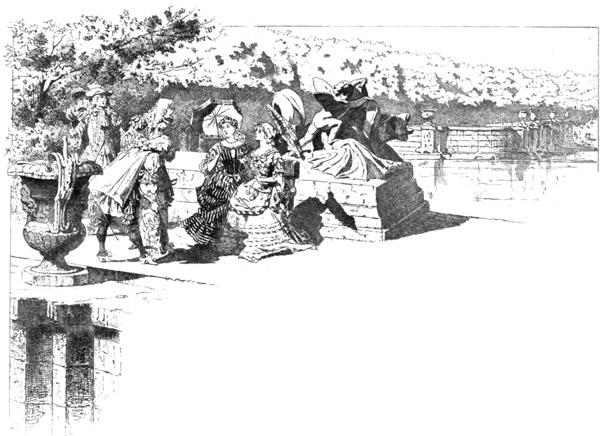
The silk Sunshade, however, properly so called, appeared in the hands of women of quality, at the promenade, on the race-course, or in the vast alleys of the royal park of Versailles, towards the middle of the reign of Louis XIV. The Umbrella of that time was an instrument astonishingly heavy and very coarse in appearance, which it seemed almost ridiculous to hold in the hand. In 1622 it was in some measure a novelty in Paris, since in the Questions Tabariniques, cited by that useful author, the late M. Édouard Fournier, in The Old and the New, we read these lines about the famous felt hat of Tabarin:—
“It was from this hat that the invention of Parasols was drawn, which are now so common in France that they are no longer called Parasols, but Parapluyes (Umbrellas) and Garde-Collet (collar guards), for they are used as much in winter against the rain as in summer against the sun.”
The most ancient engraving or documentary image of French manners in which we see a Parasol is dated 1620. It is the frontispiece of a Collection of Saint Igny, The French Nobility at Church.
Parasols, however, were still very little used in the seventeenth century; the Précieuses who, instead of saying “It rains,” cried out, “The third element falls!” would never have missed finding some amiable qualificative to designate this necessary article invented against Phœbus and Saint Swithin. But Saumaise reveals to us nought on this subject, and one would be almost tempted to believe that the Philamintes and Calpurnies attached no importance to this “rustic and movable Pavilion.” What, however, is clearly shown by the ancient prints is the employment of the Parasol in the form of a small round canopy which ladies of quality had borne by their valets when walking in the primly arranged gardens of their lordly residences, whilst the gentlemen marched before, wrapt in their cloaks, with the felt hat inclined over one eye.
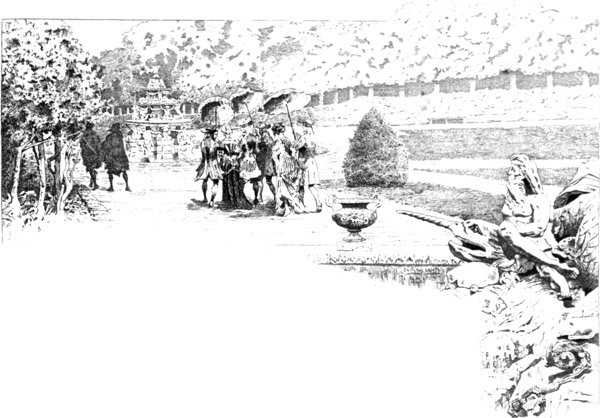
Parasols were then of so coarse a form, and their weight made them so difficult to be carried, that they could not be easily utilised by ordinary people; they are never found in any of those very curious engravings which give a confused idea of the rumblings and mobs of the streets under Louis XIV. Boileau and François Colletet have not mentioned them amidst the Obstacles and Bustle of Paris; and the Cries of the Town which have come down to us do not indicate that in the seventeenth century any man with “’Brella-a-a-a-s to sell!” had contributed his mournful melopæa to the lagging cries of the street.
That is easily understood. We see that a Parasol, in the middle of the grand century, weighed 1600 grammes, that its whalebones had a length of 80 centimetres, that its handle was of heavy oak, and that its massive carcass was covered with oilcloth, with barracan, or with coloured grogram. The whole was held by a copper ring fixed at the extremity of the whalebones; it was the labour of a porter to preserve oneself, with an instrument like this, from the pelting shower! Better still: often these Parasols were made of straw, and, if we believe the Diary and Correspondence of Evelyn, about 1650, they affected in some degree the form of metal dish-covers.
However, it is something very like a Sunshade which we find about 1688 in the hands of a woman of quality, dressed in a summer habit à la Grecque, of which N. Arnoult has preserved faithfully for us the pleasing outline, in a pretty design made common by engravings. This Parasol has the appearance of a mushroom, well developed and slightly flattened at its borders; the red velvet which covers it is divided into ribs or rays, by light girdles of gold, and the handle, very curiously worked, is like that of a distaff, with swellings and grooves executed by the turner. Altogether, this coquette’s Sunshade is very graceful, and of great richness.
In the most varied literary works of the seventeenth century, memoirs, romances, varieties, dissertations, poems, enigmas, carols, and songs, there is not a word of allusion to the Parasol, there is an entire penury of anecdote, nothing whatever on the subject. It is useless to torture your understanding, to look through a miserable needle’s eye, at the Letters of Madame de Sévigné, the gossip of Tallemant, the Conversations of Mademoiselle de Scudéry, the Anecdotes of Ménage, the poetical collections, the different Chats, the Medleys—it is but a library overturned to no purpose, a headache gained without the slightest profit.
In a MS. collection, written about 1676, which relates the memoirs of Nicolas Barillon, a comedian, this phrase alone attracts our attention: “The days being very hot, the lady carried either a mask or a Parasol of the most precious leather.”
From this mask or Parasol of precious leather no conclusion can be drawn better than that of the Dictionaries of the Anti-Academician, Antoine Furetière, or of the learned Richelet, where we find a résumé of the ideas of the time. Here, then, is the definition of the first:—
Parasol, s. m., a small portable piece of furniture, or round covering, carried in the hand, to defend the head from the great heats of the sun; it is made of a circle of leather, of taffety, of oilcloth, &c. It is suspended to the end of a stick; it is folded or extended by means of some ribs of whalebone which sustain it. It serves also to defend one from the rain, and then it is called by some parapluie (umbrella).
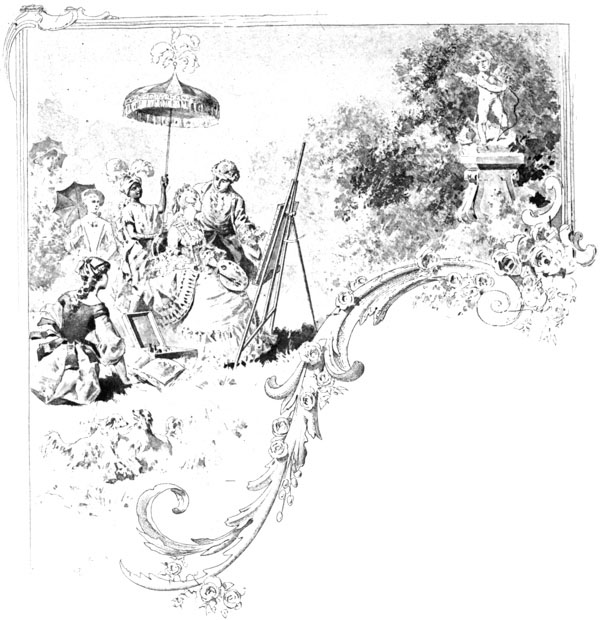
The definition of Richelet is almost the same. He adds, however, these words: “Only women carry Parasols, and they only in spring, summer, and autumn.” Richelet, it is true, borders upon the eighteenth century, since he died but a little before the end of the reign of Louis the Great. This brings us to the aurora of the Regency, and a renaissance then occurs in feminine coquetry. We are now about to find our Sunshade in gallant parties, supported by little turbaned negroes; already we see it decorated with fringes of gold and trimmings of silk, enhanced with plumes of feathers, mounted on Indian bamboos, covered with changing silks, embellished in a thousand and one ways, worthy, in a word, of casting a discreet shade on those rosy and delicate faces which Pater, Vanloo, Lancret, La Rosalba, and Latour did their best to reproduce in luminous paintings or fresh pastels, those enchanting pictures where the coquetry of the past smiles still.
Like all objects of adornment in the hands of women, the Sunshade in the last century became, like the Fan, almost a light and graceful plaything, serving to punctuate an expression, to round a gesture, to arm an attitude of charming reverie, in which, guided by pretty indolent fingers, its point traces vague designs upon the sand. Before the burning breath of amorous declarations, often the frail Sunshade escapes from the hands of a beauty, in sign of armistice, and as an avowal of abandonment.
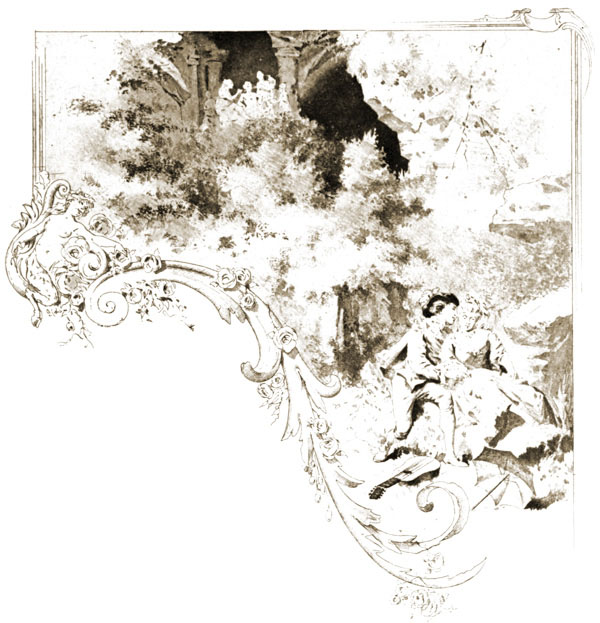
Be it open, and daintily held over powdered hair, or shut, and brushing the brocaded petticoat, it is always the “balancing pole of the Graces.” It gives a value to listlessness on the rustic seat of the parks, under the vaulted roofs of grottoes, and it adds a piquancy to the frowardness of the feminine chatterers, who defend themselves by making fun of libertine attacks. In a word, in the light amorous allegories of the century, it is worthy to appear in those love-duets of Leanders and Isabellas, which Watteau often composed with so rare an art of refinement.
From the middle of the last century the Umbrella of taffety became the fashion at Paris. Caraccioli, in his Picturesque and Sententious Dictionary, gives us evidence of this: “It has long been the custom,” he says, “not to go out save with one’s Umbrella, and to trouble oneself by carrying it under one’s arm. Those who wish not to be confounded with the vulgar, prefer to run the risk of getting wet to being regarded as people who walk on foot, for the Umbrella is the sign of having no carriage.”
The Parasols were made by the purse-makers, and when, by an edict of August 1776, the manufacturers of gloves, purses, and girdles were united in one community, an article thus conceived may be read in their statutes: “They alone also still have the right to make and manufacture all sorts of Umbrellas and Parasols, in whalebone and in copper, folding and non-folding, to garnish them atop with stuffs of silk and linen, to make Umbrellas of oilcloth, and Parasols adorned and ornamented in all sorts of fashions.” According to the Journal of a Citizen, published at the Hague in 1754, the price of folding Parasols was then from 15 to 22 livres a piece, and the Parasol for the country from 9 to 14 livres.
We must, however, believe that the common folk of Paris did not yet dare to purchase Parasols, since Bachaumont, in the Secret Memoirs, dated 6th September 1769, records the following enterprise:—
“A company has lately formed an establishment worthy of the town of Sybaris. It has obtained an exclusive privilege to have Parasols, and to furnish them to such as fear being incommoded by the sun during the crossing of the Pont-Neuf. There are to be offices at each extremity of the bridge, where the voluptuous dandies who are unwilling to spoil their complexion, can obtain this useful machine; they will return it at the office on the other side, so alternately, at the price of two farthings for each person. This project has already been put in execution. It is announced that if this invention succeeds, there is authority to establish like offices in other places in Paris, where skulls might be affected, such as the Place Louis XV., &c. It is probable that these profound speculators will obtain the exclusive privilege of Umbrellas.”
Did this enterprise succeed? We cannot tell. All that is certain is, that it was tried many times in our own epoch by innovators, who had no idea that even the letting out of Parasols was not absolutely new under the sun.
A great progress was realised in the eighteenth century in the manufacture of Sunshades for ladies. The small ordinary Parasols became exceedingly light, and charmingly decorated. In a picture of Bonaventure Delord, in the Louvre, we find the exact type of these coquettish Sunshades of the last century. One, which is held by a laughing beauty in the midst of a picnic, is mounted on a long stem, and the top, made of yellow buckskin, appears to have four sides; a cap of turned copper, and of a very pretty shape, profiles its tiny Chinese gable on the grass.
So, too, may be seen in the collection of Madame la Baronne Gustave de Rothschild, a very curious Sunshade which belonged to Madame de Pompadour. It is of blue silk superbly decorated with wonderful Chinese miniatures in mica, and ornaments in paper very finely cut and affixed to the background. Fortified probably with such a Sunshade as this, the pretty favourite, at the time of the rage for pastorals, which followed the appearance of Bouffier’s story of Aline, betook herself to the shady walks of the Petit Trianon at Versailles, with her female friends, to see the white sheep milked, and to steep the carnation of her lips in the warm milk, of which the young Abbé De Bernis—who gathered so willingly madrigals and bouquets for Chloris—compared the whiteness to that of her peerless bosom.
Everywhere, in the pictures and engravings of the century we catch a glimpse of these same light Sunshades or Umbrellas which approach so nearly those of the present day. We see the one or the other in the Prints of Moreau the Younger intended to serve as a Companion to the History of Fashions and Customs in France, in the Crossing the River, after Gamier, in public festivals, as well as amidst the hubbub of the crowds, which Moreau shows us in the Great Court Carriages in 1782, as in the minor popular rejoicings, like The Ascension of a Fire-balloon, after the engravings of the period. The Sunshade introduces also a little touch of gaiety into the large pictures of Joseph Vernet; in his View of Antibes and his Port of Marseille the painter has placed in the hands of pretty promenaders adorable little pink Sunshades, through which the light seems to filtrate, in the silk’s transparency. Later on, lastly, before the royal sitting of 23d June, 1789, the Umbrella plays its historic part in the Revolution, by protecting the gentlemen of the Third Estate, left at the door of the Assembly under a pelting rain, not very well disposed to receive the King’s order, “Gentlemen, I command you to disperse yourselves at once!”
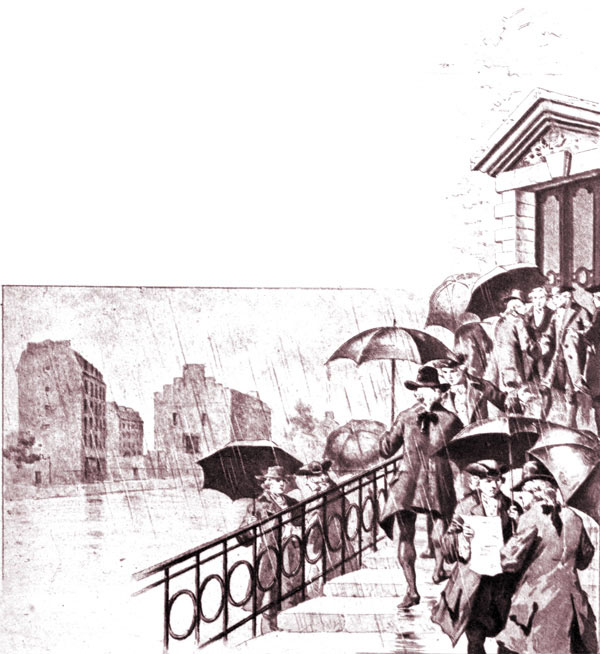
Strange! at a time when the Parasol was generally adopted in France, it was yet very little known in England and among the peoples of the North. At Venice even, where we have made our researches, the first person who used a Sunshade, about the middle of the eighteenth century, was Michel Morosini, “a senator of high rank,” who, braving all prejudices, appeared one day in his gondola, bearing a small green Sunshade, unarched, of a quadrangular form, surmounted by a tiny copper spire, of very delicate workmanship. The fair ladies of Venice adopted this “indispensable” after this manifestation of the noble Michel Morosini, but the Sunshade, nevertheless, appeared not in all patrician hands in the gondolas of the Great Canal, and on the Piazza of Saint Mark, till about the year 1760.
In England, in the first half of the last century, the Parasol and the Umbrella were hardly ever used; however, in a passage of the Tatler, Swift alludes to one of them in 1760, when he describes for us a little sempstress, with her petticoats tucked up, and walking along in a great hurry, whilst the rain trickles down from the Umbrella:
The tucked-up sempstress walks with hasty strides,
While streams run down her oiled Umbrella’s sides.
Again, there is at Woburn Abbey an admirable portrait, painted about 1730, of the Duchess of Bedford, followed by a little negro, who holds above her head a sumptuously decorated state Parasol.
It is right to say that during the first years of the last century people could not procure Umbrellas in London except in the coffee-houses, where they were placed in reserve to be let out to customers during heavy showers of rain. The first English citizen who really introduced absolutely and unconditionally the Umbrella to the nation was Jonas Hanway, the founder of the Magdalen Hospital. This audacious man—for audacious he must have been thus to brave the prejudices of a people the most prejudiced in the world—this rash person had the courage never to go out into the streets of London without his Umbrella from the year of our Lord 1750. Like the majority of innovators, he was scoffed at, reviled, derided, caricatured; he had to bear in his daily walks the quips and insults of the mob, the stones and jostlings of the vagabond boys; but he had also the honour of triumphing, and of seeing by degrees, after twenty years of perseverance, his example followed to such an extent that at the time of his death in 1786 he could declare with pride that, thanks to him, the Umbrella was for ever implanted in England, an imperishable institution.
To-day, our neighbours across the Channel talk of erecting a statue to Jonas Hanway, as a homage publicly paid to a philanthropist. It might be asked in what attitude this peaceable humanitarian is to be represented, whether the Parasol of bronze is to remain shut up in his right hand, or if it will be opened in all its amplitude over the head of its protector, thus become its protégé.

About the time when Jonas Hanway died, Roland de la Platière made, in his Manufactures, Arts, and Trades, this curious observation: “The use of Parasols is to such an extent established in Lyons, that not only all the women, but even the men, would not cross the street without their little Parasol in red, white, or some other colour, garnished with blonde lace, an article which, owing to its lightness, can be carried with ease.”
At the approach of the Revolution, the Umbrella became popular, and served as a tent for the fishwomen and other feminine hucksters. Then first appeared the enormous Umbrella of red serge among the people of the markets, and the ordinary Umbrella in the hands of the “Sans-Jupons” (the unpetticoated). Amidst the enthusiasms and revolts of the streets the Umbrella was frantically waved by the hands of the women of the people, and when, on the 31st May 1793, Théroigne de Méricourt undertook her ill-starred defence of Brissot, in the midst of a multitude of old hags, who cried “Down with the Brissotins!” Umbrellas were lifted like so many improvised swords over the Liégeoise, smote her in the face, lashed her everywhere, scanning as it were with their strokes the odious cries of “Ah! the Brissotine!” and provoking in the unhappy revolutionary Amazon the madness of which she died so sadly at the Salpêtrière.
The Parasol of the Jacobins for a time made a show of severity, in opposition to the knotty sticks and coquettish Parasols of the Muscadins (dandies) and Incroyables (beaux); the Merveilleuses (feminine exquisites), on the other hand, hoisted vaporous Sunshades like their vestments of nymphs. Then it was that fashion gave their due to the rights even of this frail protector of the Graces; every kind of extravagance was allowed, every stuff accepted, however dazzling and however precious. In the public gardens of Paris, all the fashionable beauties displayed unusual luxury in the decoration of their Sunshades; there were tender greens, figured gold stuffs, flesh-coloured tints with scarlet fretworks, tender blues trimmed with silver, Indian cashmeres or tissues, the whole mounted on handles of affected roughness or of exquisitely delicate work. Ma paole supême, as the exquisite used to say, it must be seen to be believed. Nothing could be more coquettish than these Parasols, streaked, striped, pied, fretted, as the complement of a dress à l’Omphale, à la Flore, à la Diane, appearing in a swiftly driven carriage, above a jacket à la Galatée, or a tunic au Lever de l’aurore, amidst egrets, plumes, tufts of ribbons, and every kind of feminine adornment.
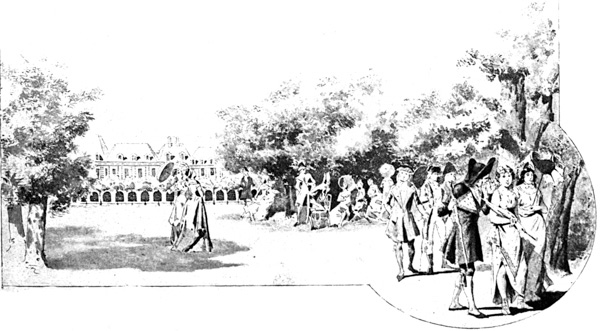
Towards the close of the eighteenth century, the Sunshade was always covered with the most fashionable tints and with stuff of the latest taste of the time. Parasols were to be seen dressed in stifled sighs, and garnished with useless regrets, others adorned with ribbons aux soupirs de Vénus (Venus’ sighs), whilst the fashion exacted by turns such colours as coxcombs’ bowels, Paris mud, Carmelite, flea’s thigh, king’s eye, queen’s hair, goose dung, dauphin’s dirt, opera flame, agitated nymph’s thigh, and other names which were the singular qualificatives of particular shades, the rage and infatuation of the hour.
The young priests carried a light violet or lilac Parasol, to remain in the tone of their general dress—perhaps by episcopal orders. In the same way, the Roman Cardinals are still followed in their walks by a deacon, carrying a red Parasol, which makes part—like the hat—of the ordinary luggage of the “Monsignori.”
This word “luggage,” which has just fallen from our pen, would seem to call the attention to the rôle of the Sunshade or the Umbrella in the Travels of the last century. Was the Parasol considered as indispensable luggage before going on any expedition? We cannot affirm this. The author of A Journey from Paris to Saint-Cloud by Sea and by Land writes, before embarking at Pont-Royal: “I kept for my personal carriage only my repeater, my pocket-flask full of sans pareille water, my gloves, my boots, a whip, my riding-coat, my pocket pistols, my fox-skin muff, my green taffety Umbrella, and my big varnished walking-stick.” But here we have more of a pretty conceit of the eighteenth century, a sort of cotquean traveller, who encumbers himself with useless objects. We have consulted many Almanacks serving as Guides for Travellers, and containing “a detail of everything which is necessary to travel comfortably, usefully, and agreeably,” from 1760 to 1765: nowhere, however, was the Umbrella prescribed, either for foot passengers or for those on horseback; on the contrary, the anonymous editor of those guides seems sometimes to laugh at the simplicity of the tourist from Paris to Saint-Cloud, and he adds that a traveller in good health ought to content himself with strong boots and a cloak of good cloth. Even a walking-stick, he says, often consoles the walker only in imagination.
The Umbrella-Walking-stick—who would believe it?—was, however, known from 1758, and very convenient Parasols were then made, of which the dimensions could be reduced so as to suit the pocket. A certain Reynard announced in 1761 Parasols “which fold on themselves triangularly, and become no thicker or more voluminous than a crush-hat.” These Umbrellas were, it seems, very common about 1770: the stick was in two pieces, united by a screw, and the ribs were folded back several times.
But let us not abandon the chronological order in returning thus upon our own steps, after the example of a romance writer of 1840. We have scarcely caught a glimpse of the Sunshade in our passage through the sixteenth, seventeenth, and eighteenth centuries, in the desultory speed of this free chat, in which our prose leaps as in a steeple-chase of charming designs. We have confounded occasionally the two denominations Sunshade and Umbrella in the more general word Parasol: but if we have travelled a little in every direction, we have not had the leisure to stop anywhere as a lounger or analyst. And here we are at the beginning of this century, at the Empire, but the nation is helmed, the sun of Austerlitz requires not a Sunshade; woman holds merely the second place in this hour in which France handles but the costly toys of glory, and if we find at all an Umbrella, it is in the field, with the general staff of the army, during some misty night, when it is used to shelter the commander-in-chief, who studies on his map the plan of battle of the morn.

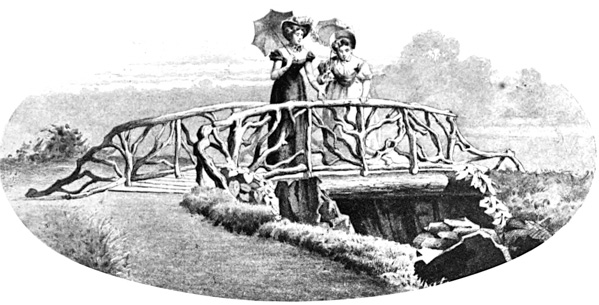
The Sunshade shows more favourably in the hour of peace, during the Restoration. All the journals of fashion of the time give us curious and varied specimens of it in their steel engravings, hand-coloured, which show us, during those days of a lull, languid ladies in the midst of amusing decorations, in winter amidst snowy country scenes, in summer in a park of profound distances, on some rustic bridge, where the mistresses of the manors of that time allowed their romantic reveries slowly to wander. We can follow in the innumerable Monitors of elegance, which appeared from 1815 to 1830, from year to year, from season to season, the variations introduced into the decoration of the little ladies’ Parasols. Look for a moment: here are Sunshades, covered with coloured crape, or damasked satin, with checkered silk, streaked, striped, or figured; others enriched with blonde or lace, embroidered with glass-trinkets, or garnished with marabou feathers, with gold and silver lace, or silk trimming; the fashionable shade is then very light or very deep, without intermediate tones: white, straw yellow, pink or myrtle-green, chestnut and black, purple-red, or indigo. But a hundred pages would not suffice us to catalogue these fashions of the Sunshade: let us pass onward.
The use of the Umbrella extends itself little by little through all classes; already in the slang of the people it is known under the names of the Mauve(?), the Riflard, the Pépin, the Robinson. Umbrella manufactories have, since the beginning of this century, propagated rapidly in France. Before 1815—this seems scarcely credible—Paris had no great manufactory of Parasols. But from 1808 to 1851 alone, we can reckon more than 103 patents for inventions and improvements relating to Umbrellas and Sunshades. Among the most extravagant patents, we must quote, after M. Cazal:—
(1.) A patent for invention of an Umbrella walking-stick with a field-glass;
(2.) A patent for invention of Umbrellas and Sunshades combined with walking-sticks, shutting up in a copper case, in the form of a telescope;
(3.) A patent for invention of an Umbrella walking-stick, containing diverse objects for writing or other purposes, and called Universal Walking-stick;
(4.) A patent for invention of methods of manufacturing Umbrellas and Sunshades, opening of themselves, by means of a mechanism placed inside the handle;
(5.) A patent for an Umbrella walking-stick, of which the sheath may be folded at pleasure, and carried in the pocket.
In spite of these genially grotesque inventions of Umbrella-Telescopes and of Parasol-Walking-sticks, we have always come back to the Umbrella simple, without mechanism, or to a light stick without any pretensions to defend us from the rain. There are so many complications in an object intended for many uses, that an educated mind will always refuse to adopt it.
But without speaking further of the technology of the Umbrella, we will relate an anecdote which ran through all the minor journals of the Restoration, terminating like an apologue. We shall adopt the form and style of the time in our narrative of this little historic story, which should be entitled The Sunshade and the Riflard.
One fair summer afternoon, the promenaders in the Parisian Champs Elysées might have seen, seated on a chair beside a pretty woman, whose interesting situation was plainly visible, a peaceable citizen making an inventory of all his pockets in their turn, without finding the purse from which he intended to draw the few halfpence which the chair-proprietress demanded.
The search is useless; it is impossible for him to pay;—the proprietress indignant, almost rude, threatening to make a disturbance, is only satisfied by the gentleman taking from the hands of his companion a Sunshade of green silk, with fringes, mounted on a reed, and a yellow glove, and giving them to the irascible lady, saying to her, “Well, madam, keep this Sunshade as a pledge, and give it to no one unless he offer you a Glove the fellow of this.”
The pair departed, slowly arrived at the Place de la Révolution, then at the Boulevard de la Madeleine, when they were surprised by a violent shower; cabs were not to be had, the rain increased, they were forced to seek refuge underneath a carriage entrance. The peaceable citizen had already taken his companion to this shelter, when a “portier,” with an otter-skin cap, came out, beseeching the lady and gentleman to accept the hospitality of his little room, where a leathern arm-chair and a stool were immediately, and with very good grace, offered to the invited pair. The rain still pouring down, the “portier,” more and more affable, took from a corner of his small lodge a superb Umbrella of green serge, and offered it to his guests, declaring that all he had was at their service.
The gentleman, in much confusion, accepted with many thanks the Umbrella, and sheltering with it the interesting young woman, who had tucked up her dress in the prettiest style, they both ventured out into the midst of the deluge.
. . . . An hour afterwards, a footman in very stylish livery returned to the honest “portier” cobbler his precious Umbrella, with four notes for a thousand francs, from the Duke de Berry; next directing his course to the Champs Elysées, that same footman sought out the chair-proprietress, and said to her:
“You recognise this Glove, Madam? Here are four pence, which my lord, the Duke of Berry, has ordered me to remit to you, to redeem the Sunshade of the Princess Caroline.”
Touching and eternal legend of virtue, not without a recompense!
Under Louis Philippe, the Umbrella or Riflard became patriarchal and constitutional; it represented manners austere and citizenlike, and symbolised the domestic virtues of order and economy. It might be set in the royal trophy in saltier with the sceptre, and it became a part in some sort of the national militia, with the attributes of angling, culinary laurels, and other symbols of Philistine life.
All the independents of Paris, Bohemians, literary men with flowing manes, and artists chanted in the Rapinéide, all the hirsute folk of the years 1830 to 1850 rose in insurrection against the “Pépin” of the burgess. This word Pépin was then an epigram against Louis Philippe, whose pear-shaped head was caricatured, and who never left his home without his Umbrella.

Anglomania had not yet penetrated, as in the present day, into French manners; and the dandyism of 1830, which pretended that the carrying of a walking-stick required a particular skill, repelled the Umbrella as contrary to veritable elegance. The Umbrella was countrified, the property of gaffer and gammer; it was tolerable only in the hands of one who had long renounced all pretensions to any charm, and dreamed no more of setting off in the promenade the haughty profile of a conqueror. In the cross ways, in every public place in Paris, the large Parasol, red, or the colour of wine-lees, had become, as it were, the ensign of the strolling singer who retailed Béranger to the crowd; it served as a shelter for acrobats in the open air; it surmounted the improvised trestles of the sellers of tripoli, of an universal ointment; it ascended even the chariot of the quacks; later on it served as a set-off for the plumed helmet of Mangin, the pencil merchant; and it is still under a copper Parasol, commonly called Chinese bells, that the man-orchestra causes an excitement in the court-yards by ringing his little bells.
In the provinces, on market or great fair days, the Umbrellas opened in picturesque confusion above the flat baskets and provisional establishments of the country women; there were red, faded blue or chestnut ones, inexpressible green or old family Umbrellas, heirlooms descended from generation to generation, which protected the little rural tradeswomen, and added a particular character full of colour to these primitive markets of little towns.
The Umbrella! we behold it in the dreams of our school-days. Here is the severe and sombre Umbrella of the headmaster, symbol of his pedantic authority, when he passed us in review in the cold and damp playground. Here is the Riflard of the poor usher, a celebrated Pépin, covered with a mottled cotton-stuff, its bill-headed handle polished by his unctuous clasp. And here, above all, is an Umbrella greeted with loud acclaim, a festive Crusoe, which followed us when out walking, as the sutler follows the regiment on the march, the Umbrella of Mother Sun, as we used to call it: Mother Sun! an honest jolly wench, with her head in a silk pocket-handkerchief tied under her chin, who installed herself beneath the shelter of her improvised tent about our playtime, to sell to her noisy children cooling lemonade, fruit, barley-sugar, and little white rolls stuffed with hot sausages.
But let us leave these souvenirs, which carry us too far away, and return to the Sunshade between 1830 and 1870. If we wished to show only its transformations during these forty years, we should have to write a volume quite full of coloured vignettes to give a feeble idea of the history which fashion creates in an object of coquetry. About 1834, in the journal called Le Protée, we see fashion personified under the traits of a young and pretty woman visiting the finest shops in Paris; she fails not to go to “Verdier, in the Rue Richelieu, for Sunshades,” and chooses two—one a full-dress Sunshade, in unbleached silk casing, mounted on a stick of American bindweed, with a top of gold and carved coral; the other in striped wood, having a similar top with a fluted knob, and covered with myrtle green paduasoy, with a satin border.
Let us skip over some hundreds of intermediate varieties to look a dozen years afterwards, under the Second Republic, at the Sunshade described by M. A. Challamel in his History of Fashion: “As soon,” says this writer, “as the first ray of sunshine appeared, ladies armed themselves for their walks or morning calls with little Sunshades, entirely white, or pink, or green. Sometimes the Sunshades called ‘Marquises’ were edged with lace, which gave them rather a ragged appearance; or having the shape of little Umbrellas, the Sunshades could serve at need against a sudden storm. Very soon we saw Sunshades à dispositions bordered with a figured garland, or a satin stripe of the same colours, or blue or green on unbleached silk, or violet on white or sulphur.”
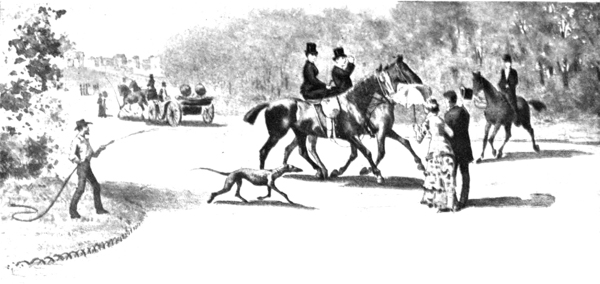
A fashion, not, it will be allowed, in the very best taste:—Up to 1853 or 1854, we find no innovation worthy of exciting our enthusiasm; it is only in the first days of the Second Empire that we can see a marked change. The straight Sunshades were then abandoned to introduce Sunshades with a folding stick, principally for those made in satin and in moire antique, bordered with trimmings or set off with streamers. These Sunshades were called “à la Pompadour,” and they were worthy, in a certain degree, of the beauty who personified grace and delicate elegance in the eighteenth century; they were embroidered after the old fashion with gold and silk, and on the richness of the stuffs was cast or “frilled in” Chantilly, point d’Alençon, guipure, or blonde. The folding-sticks were of sculptured ivory, of carved mother-of-pearl, of rhinoceros horn, or of tortoise-shell. It is with this light Sunshade that the Parisian ladies saluted the Empress, caracoling by the side of the Emperor, at the commencement of his reign, on their return from the Wood, in the Champs Elysées, which began to look beautiful, as everything looks beautiful at the spring-tide of years, as well as at the springtime of governments. All in nature has surely its fall of the leaf, after having had the verdure of its blossom!—all tires, all passes, all breaks: men, kings, fashions, and peoples!
The Sunshade is found to-day in the hands of every one, as it should be in this practical and utilitarian age. There is not, at the present hour, any woman or girl of the people, who has not her sunshade or her satin en-tout-cas—it seems to be the indispensable complement of the toilet for the promenade; and our modern painters have so well understood this gracious adjunct of feminine costume, that they take very good heed not to forget, in a study of a woman made in a full light, a rosy head with dishevelled hair, on the transparent ground of a Japanese Sunshade, thus producing an exquisite work with all freshness of colouring, and discreet shadows sifted upon sparkling eyes or a laughing mouth. On Sundays and holidays, in the jostlings of the crowd at suburban fêtes, it is like an eddy of Sunshades; such the spectacle of ancient besiegers, who covered themselves with their bucklers and made the “tortoise,” so in the shimmer of the summer sun in the great Parisian parish festivals: gingerbread fairs of Saint-Cloud or Vaugirard, the Sunshade is on the trestles and among the promenaders; it protects equally the girl dancing on the tight-rope and the respectable citizen’s wife in her Sunday best, who rumples the flounce of her petticoats in these popular gatherings.
Surely the Sunshade adds new graces to woman! It is her outside weapon, which she bears boldly as a volunteer, either at her side, or inclined over her shoulder. It protects her head-dress, in supporting her carriage, it surrounds as with a halo the charms of her face.
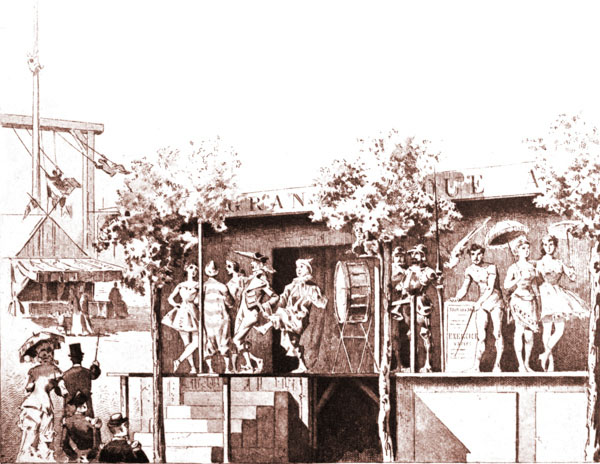
“The Sunshade,” writes M. Cazal—or rather Marchal, as the so-called Charles de Bussy, who edited, in the name of the manufacturer, the little work already quoted,—“the Sunshade, like a rosy vapour, attenuates and softens the contour of the features, revives the vanished tints, surrounds the physiognomy with its diaphanous reflections. There is the Sunshade of the great lady, of the young person, of the tradesman’s wife, of the pretty lorette, of the little workwoman, just as there is the Sunshade of the town, of the country, of the garden, of the bath, of the barouche, and the Sunshade-whip.”
“How many volumes,” continues the same writer with animation, “would be required to describe in its thousand fantasies the kaleidoscope of feminine thought in the use of the Sunshade? Under its rosy or azure dome, sentiment buds, passion broods or blossoms; at a distance the Sunshade calls and rallies to its colours, near at hand it edifies the curious eye, and disconcerts and repels presumption. How many sweet smiles have played under its corolla! How many charming signs of the head, how many intoxicating and magic looks, has the Sunshade protected from jealousy and indiscretion! How many emotions, how many dramas, has it hidden with its cloud of silk!”
M. Charles Blanc, less dithyrambic, in his Art in Dress and Ornament, commences his chapter on the Sunshade—“Do you imagine that women have invented it to preserve their complexion from the heats of the sun? . . . . Certainly, without doubt; but how many resources are furnished them by this need of casting a penumbra over their face, and what a grudge they would have against the sun, if it gave them no pretext for defending themselves against his rays! In that work of art called a woman’s toilet, the Sunshade sustains the part of the chiaro-oscuro.
“In the play of colours it is as a glazing. In the play of light it is as a blind.”
For the last dozen years, fashion has varied, with every new season, the mode and covering of Sunshades. To-day they have become artistic in all points, and after having been in turns in spotted foulard, and set off with ribbons or lace, after the Parasol walking-stick, the maroon or cardinal-red Parasol, have succeeded the checkered taffetas, the Madras cretonnes, the Pompadour satins, the figured silks. Their handles are adorned with porcelain of Dresden, of Sèvres, or of Longwy, with various precious stones, and with jewels of all sorts; and lately, among some wedding presents, amidst a dozen Sunshades, one remarkable specimen was entirely covered with point lace, on a pink ground clouded with white gauze, having a jade handle with incrustations of precious stones up to its extreme point. A golden ring gemmed with emeralds and brilliants, attached to a gold chain, served as a clasp for this inestimable jewel.
But in this style of hasty conference in which we are running from the Sunshade to the Umbrella, let us not neglect the latter, whose last name is paratrombe and paradéluge, which M. de Balzac, in the Père Goriot, calls “a bastard descended from a cane and a walking-stick.” The Umbrella has inspired many writers—writers of vaudevilles, romances, poetry, and humorous pieces; on it little ingenious monographs have been composed, little sparkling verses, articles in reviews, very serious from the trade point of view; many couplets have been rhymed at the Caveau and elsewhere on the Pépin and the Riflard; on the stage has been interpreted My Wife and My Umbrella, Oscar’s Umbrella, The Umbrella of Damocles, and the Umbrella of the poet D’Hervilly. This useful article has also inspired the realist Champfleury in a joyous tale, entitled—Above all, don’t forget your Umbrella! Everywhere, with variations and unheard-of paraphrases, has the social part of the Umbrella been shown to us; the meetings occasioned by it on stormy days; the Pépin gallantly offered to young girls eating apples in distress whilst it is raining on the Boulevards; we have had described to us the gentleman who follows the ladies fortified with his Umbrella, the weapon of his fight, and many tales and novels begin with one of these Parisian meetings at a street corner on a wet evening. The utility of the Umbrella in different ways has been insisted on, of the painter’s Umbrella, of the Umbrella for men called sea bath; and the sad melopæa of the French seller of Umbrellas in the street, whose prolonged cry of parrrphluie has been carefully annotated. Lastly, there have been too many pictures representing a coquettish workwoman, whose petticoats have been turned up by the wind, and whose Parasol has been turned inside out; but that which has never been written with the humour which such a subject allows, the master-piece which has never yet been accomplished, is the Physiology of the Umbrella.
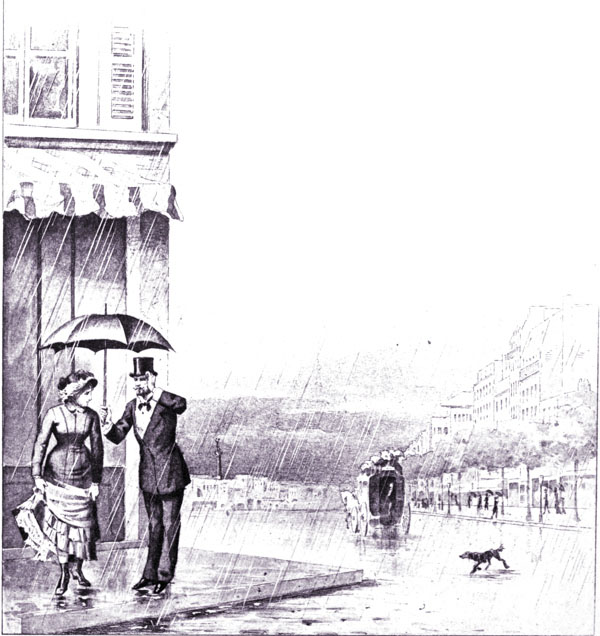
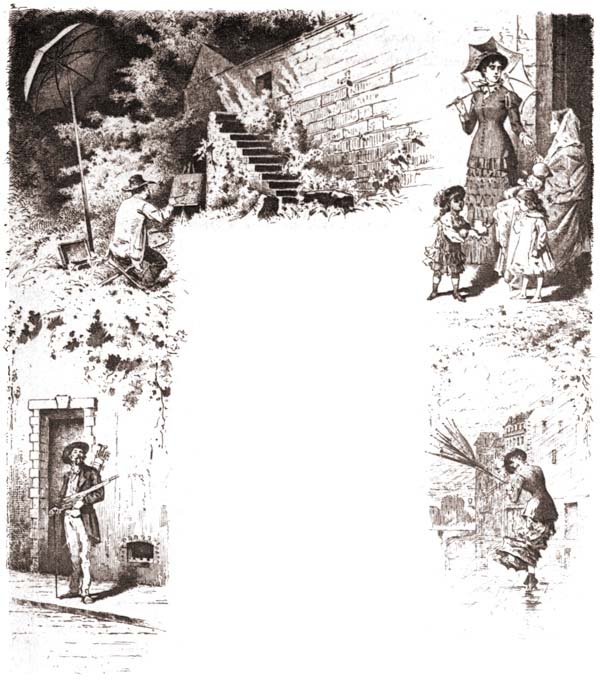
There is no doubt that bibliographers will put under our eyes a thin book of the lowest character which affects this title, and is edited by Two Hackney Coachmen, but it is nought but the “humbug” of the Umbrella—its Physiology in its entirety is yet unaccomplished. Balzac would have found therein matter for an immortal work, for there is a dash of truth in that fantastic aphorism uttered by some journalist in distress, “The Umbrella is the man.”
Eugène Scribe has left us a modest quatrain on the Umbrella, worthy of his operatic muse—
A friend of mine, new, true, and rare,
And all unlike the common form;
Who leaves me when my sky is fair,
And reappears in days of storm.
This almost equals that other quatrain, more ancient still, signed by the good abbé Delille—
This precious, supple instrument, confect
Of the whale’s bone, and of the silkworm’s grave,
With outstretched wing, my brow will oft protect
From the wet onslaught of the pluvial wave.
Have we not here Academic verse well made for the Umbrellas of the Academicians!
To come to extremes: among the popular songs, we hear the song of the Umbrella, “a ditty found in a whale”—
The good Umbrella may be sung
In many airs and ways;
The Umbrella, be we old or young,
Will serve us all our days.
It keeps true love from getting wet,
And catching cold at night;
It hides the thief, to business set,
From the policeman’s sight.
Umbrella!
Then buy yourself, for fear of rain,
A solid, useful, good, and plain
Umbrella!
In fact, for rain we cannot sell a
Much better thing than our Umbrella!
This funny song is well worth the tiresome verse sung at present—
He has not an Umbrella, well
It is no matter, while it’s fine;
But when the rain comes down pell-mell,
Why, then he’s wetted to the spine! . . . .
Certainly one ought to write a physiological monograph of these black mushrooms, which to-day protect humanity, just as one ought to rhyme a poem of the dainty Sunshade, that pretty rosy cupola, which is one of the most charming coquetries of a Frenchwoman.
We write this one ought with a vague sadness, with the discouragement which makes us wish for the future, what we should have been so glad to bury in the past. In beginning our work, we experienced a careless joy, we thought the end was near on our very entry into the field, and that we should quickly attain it, with the satisfaction of having created a little work, both complete and altogether graceful; but once on our way, ferreting without relaxation in all the literary thickets where some Parasol might lie buried, in the fold of a phrase, in the middle of a story, of an anecdote, or of a dissertation, of some fact, we have gathered so ample a harvest, our sheaf has become so large, so very large, that it was impossible for us to bind our arms about it, after having co-ordinated its various parts. It is but a few poor strays then which lie stranded here, the flotsam and jetsam of our hope, sole vestiges of a project which, like all projects, became Homeric as it grew great in the workshop of the imagination.
We end this essay, therefore, with a sentiment of ridicule, in which we laugh at our own selves, that of having dreamed of making a perfect monograph, and of having produced nothing more than a little tumbled fantasy, which ironically steals away out of sight, like that minuscular mouse, of which the mountain was once upon a time delivered in much moaning.
What matter! We must end. Let us hide our melancholy retreat by humming this last lovely burden of a poet of the school of Clairville—
’Tis called a Pépin, a Riflard,
And other viler names there are;
Not one of all the Umbrella moves.
Wisely it counts them no disgrace;
Since—child of April’s art—the loves
Oft make their quivers of its case!
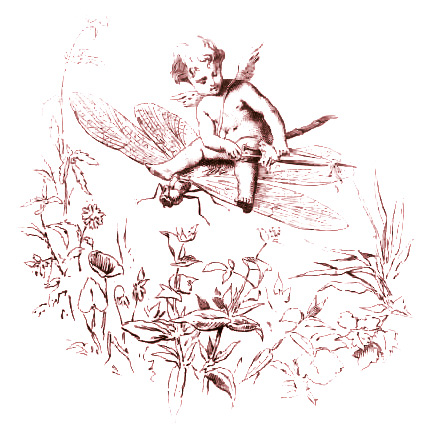
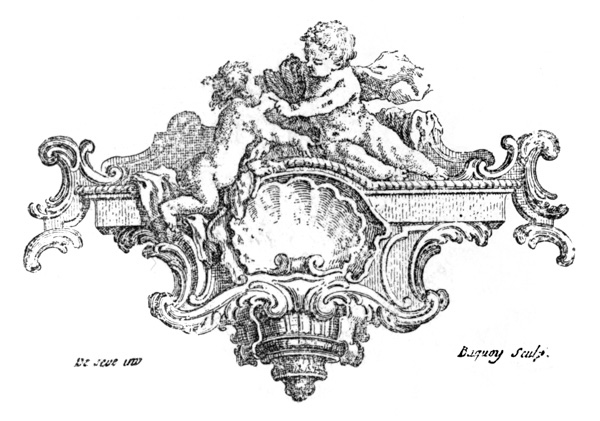
THE GLOVE
The Mitten
To Mme. H. de N.
 WELL, my dear friend, here I am, faithful as you see to my appointment; I am come deliberately to fulfil my promise, which I so imprudently gave on a certain day last season, upon a Breton strand, you remember, while contemplating one of your rosy little hands, which was whipping its sister with a long Swedish glove, in a sort of angry pet, and gave to you an appearance of wild and exquisite bluster?
WELL, my dear friend, here I am, faithful as you see to my appointment; I am come deliberately to fulfil my promise, which I so imprudently gave on a certain day last season, upon a Breton strand, you remember, while contemplating one of your rosy little hands, which was whipping its sister with a long Swedish glove, in a sort of angry pet, and gave to you an appearance of wild and exquisite bluster?
How did you manage, O Enchantress, to induce me to give my loyal word that I would write for you the History of the Glove? How! . . . who can ever say? When a pair of pretty eyes envelop you, and bathe you with their radiance, when a smile puts honey into your heart, and a tiny little hand is stretched out with open palm, seeming to say, “Take me,” every kind of will melts quickly away, consent mounts delightedly to the lips, and we promise at once everything, before we know well what we are asked.
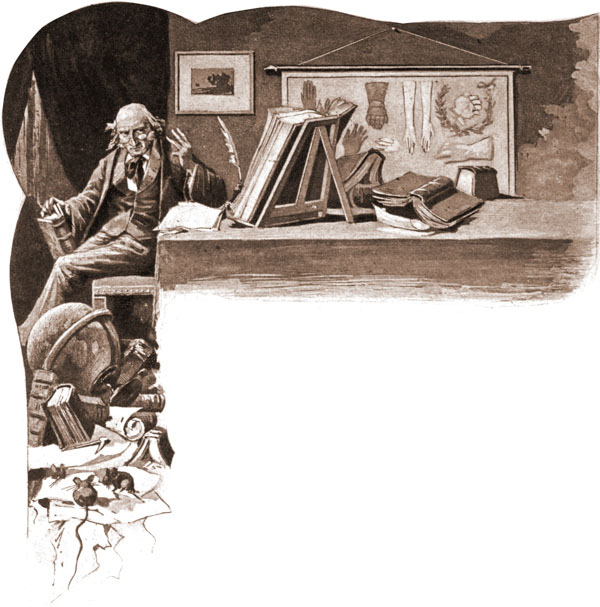
Ah, unhappy me! it is the Glove of Nessus which you have placed upon my hand! The History of the Glove! why, it is the history of the world; and I should be very ill-advised if I pretended avoir les Gants to be the first to tell that history, as ancient as it is universal.
Haunted by this debt of honour, contracted to please you, I went lately to see a learned old friend of mine, a venerable Benedictine—better than a well of science; an ocean of indulgence—to whom I exposed my foolish enterprise of the Glove and the Mitten.
Ah, my friend, I only wish you could have seen him all at once leap from his seat, look at me with compassion, examine me profoundly with his eye, and murmur three times in a tone of ineffable astonishment and sadness, as though he believed me mad—
“The Glove!—the Glove!!—the Glove!!!—
“ . . . And so it is the Glove,” he went on, when he had become a little calmer, “it is the history of this offensive and defensive ornament, of this object so complex, of which the origin is so obscure and so troublesome, it is a monograph of the Glove that you desire to write! . . . My dear child, allow me to believe that you have not reflected on what you have engaged yourself to do, let me think that you have brought more lightness than reason to the conception of this enterprise. The Glove!—Why, with the history of the Shoe, it is the most formidable work that a learned man could dare to dream of executing. Look,” he sighed, dragging forth a voluminous manuscript, “in the Bibliography of Words, a colossal work, which I have commenced, but, alas! shall never end, I see at the word GLOVE more than fifteen hundred different works, Latin, Greek, Italian, German, Spanish, English, and French, which treat of this matter, and even this is but the rudest sketch. We must consider the use of the Glove amongst the ancient Hebrews, the Babylonians, the Armenians, the Syrians, the Phœnicians, the Sidonians, the Parthians, the Lydians, the Persians, the Greeks, the Romans, &c.
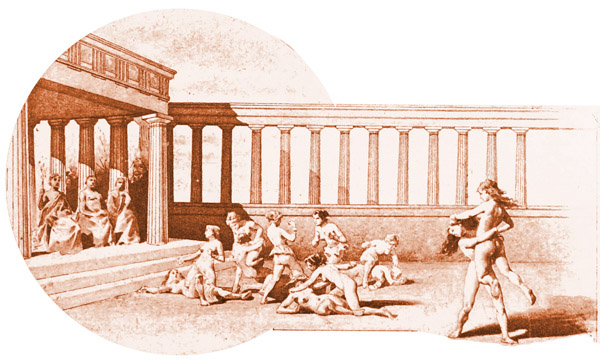
“It would be necessary to divide the work into different Books, subdivided into innumerable Chapters; thus for the etymology alone of the word Glove, in the different dialects, must be reserved a long notice of comparative philology; it would be necessary to determine if the Glove which was used by the young nude girls, who wrestled together in Lacedæmon, after Lycurgus had installed there his Lyceums and public games—if this Glove, I say, ought to be classed among the fighting mufflers or the leathern gauntlets—and how many matters besides!” And my dear old friend became still more and more excited, ever widening the question, as if, it seemed to me, it were a case of establishing a complete Encyclopedia. Diderot and d’Alembert would have grown pale before that imperturbable science, which showed mountains of folios to be cleared away, and unknown precipices to be sounded.
“But,” I hazarded in a little confusion, “I only think of writing a light treatise, a thin volume of a few pages, one of those nothings carried off by the wind, which pass for a second, like an anecdote or tale, into a pretty feminine cerebellum; I wish to give hardly a line to other countries than France, just to graze incidentally the Glove of challenge, to speak only from memory of the pontifical Gloves, to neglect the side of manufacture, the art of preparing the skins, of removing the outside skin, and so on. I only desire in one word to chat for a few instants, disconnectedly and in fits and starts, on that portion of clothing which the ancients called Chirothecæ, Gannus, Gantus, Guantus, Wanto, and Wantus, if I may trust the Glossary of Du Cange.”
“Alas, that is true,” cried my old friend, in a sadly modulated tone; “I am doting, eh? We, of the old school, it is we who are the wet blankets, the tedious savants. At the present day, when journalism is to literature what the piano is to music, an instrument upon which every one strums without any conviction, is it not necessary to cut matters short, and quickly create eternal à peu près (pretty much the sames), little light dissertations, notices made on the spur of the moment, and superficial passion? We were in our time egotists, fervent solitaries, unreadable and unread, if you will; what does it matter? When a work had fastened on our mind, we espoused it, after a legitimate love, with all the joys of generation and paternity. We wished to endow our labour with all the qualities which it seemed able to bear, to such an extent, that it became dry, rugged, and severe. But how many were the delights not to be forgotten, in those traces followed for whole days, before our utterance of the joyous Eureka!—how many inward intoxications in that slow-brooding season, in that patient labour!—how many minute investigations before resolving a historic doubt! We were the exclusives of national erudition, and thought one work sufficed for one man, when he had fed it with his life, with his watchings, with his very heart, with all the tenderness of the creative workman.
“I should like,” he continued, “to have twenty years to ride a hobby-horse, which would make me rest at stopping-places for ten, fifteen, twenty years, on a thorny work, and offer me splendid runs, full of adventure, across the highways and secret paths of science. I would commit the follies of Doctor Faustus, to return to the age of those first bibliographic loves, which have the future brilliant and open before them—and this Glove which you disdain, my dear young friend—this Glove which you dwarf to the ideal of a doll—this Glove, I would pick it up, hold it carefully, clear off with it like a cat, and ensconce myself with it in my savant’s den, to take a good long sniff at it, to study it, and to analyse it every day more and more, until at last I drew from it a serious and lasting work.
“This Glove should not be thrown at the public, like one of those challenges which recall too distinctly the celebrated Glove which Charles V. sent to Westminster by a mere scullion—an accentuation of the insult offered to the King of England—it should be cast more lovingly, as in our old romances of chivalry, the Romance of the Rose, of Rou, or of Perceforet. If I were but twenty years old, I would do with the reader as Petrarch did with Laura, in demanding of her nothing more than the favour of picking up her Glove; and I would say to him later on, after the fashion of Marot, poetically, in offering my work:—
‘Deign to receive these Gloves with goodly cheer,
My true heart’s present of the coming year.’
“And then I would speak of those Mittens with which Xenophon reproaches the degenerate Persians, of those Roman finger-stalls employed in the olive crop, and even of that glutton named Pithyllus, who carried delicacy so far as to make a Glove of a sheath of skin for his tongue.”

The good old man, kindled by his enthusiasm, became transformed; he seemed desirous to take upon himself the whole history of the Glove, which he embroidered at once with fancy and the most varied anecdote that his wonderful memory could supply. After having distinguished, in the Middle Ages, many sorts of Gloves, such as the usual Glove, the falconer’s Glove, the workman’s Glove, the feminine Glove, the military Glove, the seignorial Glove, and the liturgical Glove, he attacked with a zest bordering on frenzy the part of the Glove of the knights and men in armour of the heroic battles of the past, at a time when individual prowess could still display itself; he quoted the Chronicles of Du Guesclin and De Guigneville:—
“Rich basinets he ordered to be brought,
And Gloves with iron spikes with horror fraught.”
He showed me, without recourse to aught but his own erudition, the transformation of these iron gauntlets, first into mail, like the coat, then into movable plates of flat iron, adapted to the movements of the hand; he explained to me the lining, where the palm was of leather or stuff, and at last, exhuming the ordinances of 1311, he made me penetrate into the details of the manufacture:—
“That no one should make Gloves of plates, except the plates are tinned or varnished, or beaten, or covered with black leather, red leather, or samite, and that under the head of every nail should be set a rivet of gold.”
Ah, my fair friend, if you could have seen this strange man so suddenly taken by my subject, you would have regarded me with pity, for I could not help pouting a little at this old dean, and felt myself attacked by a sudden cowardice, at the mere announcement of the formidable researches which were to be undergone.
I took my humble leave of my most learned master, humiliated, floored by the extent of his knowledge, his laborious zeal, his powerful faith, his stubborn will. I saw that in giving you my word for a poor Glove, I had given it to a demon, who showed me a Glove of an immense shagreen skin, containing the world and its history—fantastic as a nightmare, which weighed me down. Then I swore to sacrifice a part for the rest, and not to build a cathedral when a simple cushion at your feet would suffice me for my heedless chatter. Accept then favourably this act of contrition, and let me be fully pardoned, if, à propos of the Glove, I bound along madly like a young kid, without pity for the history of costume and historic documents, which I trample under my feet, rather than see myself buried under their pyramidal bundles.
That which my old friend had probably neglected is the Legend, and to that I run.
A charming poet and a charmer, Jean Godard, a Parisian, the worthy rival of Ronsard, published towards 1580 a piece entitled The Glove. This witty nursling of the Muses pretends to show us the origin of the Glove in the burning passion which Venus cherished for Adonis. According to our poet—
“The young Adonis ever loved the field,
Now hunting the swift stag with branching head,
And now the tusked wild boar, just cause of dread.
Venus, fierce burning with his love alway,
Would never leave him neither night nor day,
But running after his sweet eyes and face,
Sought young Adonis, when he sought the chase:
Deep into forests full of gloomy fear,
The goddess followed him she held so dear.
One day, as she pursued him, bursting through
A bramble thicket, which by ill chance grew
Athwart her path, a cruel, hardy thorn
Pierced her white hand, and lo! the rose was born
From her red blood. But Venus, vexed with pain,
Lest any hurt should touch her hand again,
Bade all at once her unclad Graces sew
A leathern shelter for her hand of snow.
The lovely Graces, draped in floating hair,
No longer left their own hands free and bare,
But bound and covered them as Venus did.
And now the Glove’s true origin is hid
No longer. This is it. Fair girls alone
Wore on their hands what now is common grown.
Then came the Emperor, and then his court,
And then at last the folk of every sort.”
Charming in its naïveté, is it not, my dear friend, this fable which gives the Glove the same origin as the rose!
The use of Gloves was widely spread in the Middle Ages. They covered the wrist entirely, even with women. “The Gloves of the common people,” says M. Charles Louandre, “were of sheep-skin, of doe skin, or of fur; those of bishops were made in chain-stitch of silk with gold thread; those of simple priests were of black leather.” But what will surprise you is that, contrary to the present custom, it was absolutely forbidden to appear gloved before great personages.
In a manuscript lately published, The Sayings of the Merchants, a merchant cries, with an engaging air—
“I have pretty little bands,
And for damsels dainty Gloves,
Furred to warm their snowy hands,
These I sell to those sweet loves.”
But what were the furred Gloves of sweet loves or gentle ladies compared to those which the fair Venetians showed on the grand days of ceremonies, when the Doge prepared to mount the Bucentaur for the purpose of espousing the sea? These, according to M. Feuillet de Conches, were Gloves of silk marvellously embroidered, embossed with gold and pearls; some of them were of lace of an incomparable richness, well worthy to be offered as a present, and to figure in the budget of handsome acknowledgments. But the most wonderful were the Gloves of painted skin, like the water-colours on Fans.

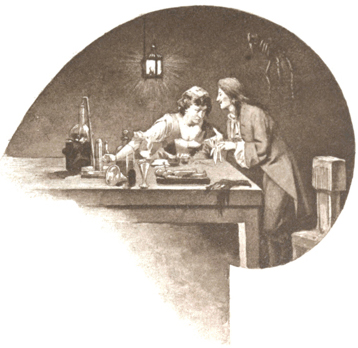
Here were country scenes, sheepfolds, pictures of ravishing gallantry, miniatures beyond price. “And even,” observes M. Feuillet de Conches, “the heels of the shoes of dandies were decorated by Watteau or by Parrocel.”
The Valois doted, you know, on perfumed Gloves; this taste was fatal to Jeanne d’Albret, who found her death in trying a pair of Gloves dexterously prepared by some Italian quack, a friend of the sombre Catherine. Consider, my friend, that with my romantic instinct, and my temperament full of love for the drama, I might find here an easy transition, and tell you, in long excited phrases, of the exploits of the Marchioness of Brinvilliers, and the grim Gaudin de Sainte-Croix; show you these sinister poisoners preparing by night their infamous Glove stock; then in a tale fantastic as the Olivier Brusson of Hoffmann, evoke the famous trial of the Marchioness, the torture, the various punishments, the burning chamber, up to the final stake. All this à propos of the Glove—who can say if such simple history would not be worth more than all the cock-and-bull stories which I am about to tell you, by compulsion, concerning the Glove and the Mittens? In very truth, I would prefer, as your vis-à-vis, to show myself a romancist, not an historian, for I should be sure of being less of a bore, more personal, and, above all—shall I avow it?—not in any degree common-place. But, as Miguel de Cervantes said, “Our desires are extremely seditious servants.” I will be then reactionary, and will close the door against these socialists of sentiment.
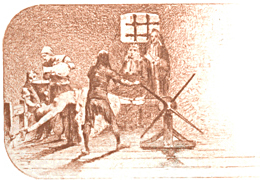
All this fine rigmarole has made me think of presenting you with a letter of Antonio Perez to Lady Rich, sister of Lord Essex, who had asked him for some dogskin Gloves:—
“I have experienced,” he writes, “so much affliction in not having by me the dogskin Gloves desired by your ladyship, that, waiting their arrival, I have resolved to flay a little skin on the most delicate part of my own body—if, indeed, any delicate part can be found upon my rude self. Love and devotion to a lady’s service may surely make a man flay himself for her, and cut her a pair of Gloves out of his own skin. But how can I pride myself on this with your ladyship, when it is my custom to flay even my very soul for those I love? Could mine be seen as clearly as my body, it would appear full of tatters, the most lamentable sort of soul in the world;—the Gloves are of dog’s skin, madam, and yet of my own, for I hold myself as a dog, and supplicate your ladyship to hold me in like regard, in requital of my faith and my passion in your service.”
What think you of this out-and-out gallant, of this “dying” passionate lover? Here it seems to me, à propos of scented Gloves, we have a Castilian gentleman exceedingly well skilled in the delicate art of offering them to ladies.
Spanish Gloves are reproached with too strong a smell; the French ladies suffer strangely from their too heady odour: Antonio Perez would certainly have been an excellent manufacturer of perfumed Gloves—discreet in his scents, distinguished in his form.
The Gloves most in vogue after the time of La Fronde were the Gloves of Rome, of Grenoble, of Blois, of Esla, and of Paris. M. de Chanteloup charged Poussin to buy him Roman Gloves, and the latter wrote back on 7th October, 1646: “Here are a dozen pairs of Gloves, half men’s, half women’s. They cost half-a-pistole a pair, which makes eighteen crowns for the whole.” The 18th October, 1649, another purchase; but this time they are Gloves scented with Frangipane, with which Poussin provided himself for M. de Chanteloup; and these he bought at la Signora Maddelena’s, “a woman famous for her perfumes.” In Paris, according to The Convenient Address Book of Nicolas de Blegny—the Bottin of 1692—there were a certain number of manufacturers of perfumed Gloves in the Rue de l’Arbre-Sec and the Rue Saint-Honoré. “There are,” says the editor of this commercial almanac, “Glove-merchants very well stocked; for instance, M. Remy, opposite Saint-Méderic, who is famous for his excellent buck-skin Gloves; Arsan, hard by the Abbey Saint-Germain; Richard, Rue Saint-Denis, at the little St. John, well known for his Gloves of Fowl-skin; and Richard, Rue Galande, at the Great King, whose commerce is in doeskin Gloves.”
The name of fowl-skin Glove doubtless astonishes you—another name was outer lamb skin; they were made for the use of ladies during the summer. The pretended fowl-skin was nothing but the epidermis of kid-skin, and the preparation of this epidermis was the real triumph of the Glove-merchants of Paris and Rome. Gloves of Canepin, or outer lamb’s-skin, were made, it is said, so delicate and thin, that a pair of them could be easily enclosed in a walnut shell.
The buck-skin or buffalo-skin Glove was specially made for falconers; it covered the right hand half up the arm, thus completely protecting it against the claws, or rather the talons, of the bird, falcon, gerfalcon, or sparrow-hawk, when it came to settle on their fist.

Hawking existed even under Louis XIII., but it was no longer the grand and splendid epoch of this aristocratic sport, so profoundly interesting. In one of his ancient legends, André le Chapelain, of whom Stendhal wrote a short biographical notice, speaks of a sparrow-hawk, to gain which the magic Glove was necessary. This Glove could only be obtained by a victory in the lists over two of the most formidable champions of Christendom. It was suspended to a golden column, and very carefully guarded. But when the knight had by his skill gained the Glove, he saw the beautiful sparrow-hawk so much desired swoop down immediately upon his fist.
Up to the age of Louis XIV., the skin Glove was destined rather for the use of men, and it was only under this Prince that Gloves mounting a long way up the arm, and long Mittens of silk netting to set off the hands of women, were generally adopted by them.
Gloves à l’occasion, à la Cadenet, à la Phyllis, à la Frangipane, à la Néroli, Gloves of the last cut worn awhile by the Précieuses, ceased to be fashionable about 1680. The custom, of which Tallemant speaks, of presenting ladies, after the banquet, with basins of Spanish Gloves, was only vulgarised in passing from the Court to the town.
Dangeau, in his Memoirs, has written a chapter on the Etiquette of Gloves and the Ceremonial of Mittens. I refer you to it without ceremony.
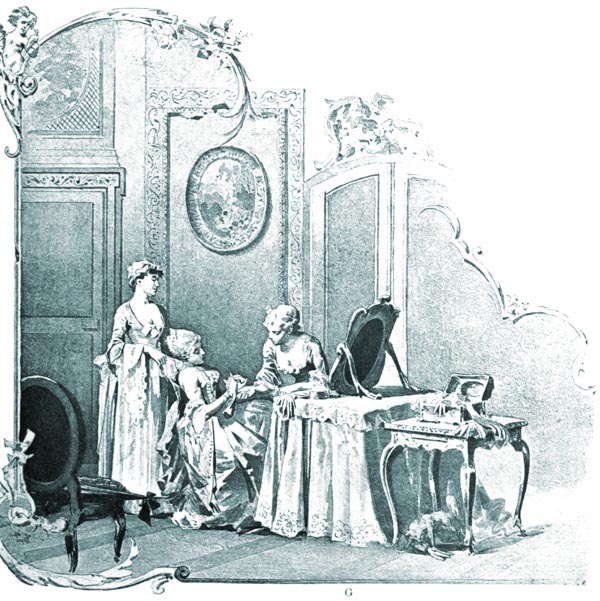
Under Louis XV., in the eighteenth century, so full of the rustle of silk, so enchanting that I fear to stop on it in your company, lest I should never leave it, the wearing of Gloves quickly became an enormous luxury. All those fair coquettes, whom you have seen at their toilets, or their petit lever, after Nattier, Pater, or Moreau, surrounded by their “filles de modes,” caused a greater massacre of Gloves at the time of trying them on, than our richest worldlings of to-day. These Gloves were of kid, of thread, and of silk; the most celebrated came from Vendôme, from Blois, from Grenoble, and from Paris; they were generally made of white skin, wretchedly sewn, but the cut was extremely graceful, with its cuff falling from the wrist over the hand, and small ribbons and fine rosettes of carnation interlaced on this cuff.
Gloves sewn after the English fashion were highly appreciated. It became a proverb, that for a Glove to be good, three realms must have contributed to it: “Spain to prepare the skin and make it supple, France to cut it, and England to sew it.”
Caraccioli maintains that a woman of fashion, about the middle of the eighteenth century, would not dispense with changing her Gloves four or five times a day. “The petits-maîtres,” he adds, “never fail to put on, in the morning, Gloves of rose or jonquil, perfumed by the celebrated Dulac.” As to Mittens, the same observer of the century notices them as specially belonging to women. “Nevertheless,” he says, “in winter the manufacturers make furred Mittens, and men now wear them when they travel.”
Madame de Genlis has this curious observation in her Dictionary of Etiquette: “If you have anything to present to a princess, and have your Glove on, you must needs take it off.”
How many anecdotes, how many literary souvenirs, the Glove of the eighteenth century summons to the thought!
You remember, I am quite sure, that pretty chapter consecrated by Sterne, in his Sentimental Journey, to the beautiful Grisette who sold Gloves, into whose shop he entered to ask his way. The pretty Glove-seller coquets with the stranger, shows herself extremely complaisant, and the sentimental traveller, to prove his gratitude for her kindness, asks for some Gloves, and tries on several pairs without finding one to suit him. But he takes two or three pairs all the same before he goes.
The story leaves a fresh feature in the mind: an English artist has fixed it with much delicacy on a remarkable canvas, which figures in the National Gallery. The authors of the Vie Parisienne were surely inspired by it a little later in their joyous libretto, when they wrote the well-known couplets of the lady who sold Gloves and the Brazilian.
Permit me also to relate to you an anecdote, rather slight in texture, of which Duclos is the hero, and which has all the flavour of his roguish age:—
The author of Manners was bathing on the flowery borders of the Seine, and giving himself up to skilled hand-over-hand, when he suddenly heard piercing cries of distress. He rushes out of the water, runs up the bank without taking time to slip on his “indispensables,” and finds a young and charming woman, whose carriage had just been overturned in a rut. He hastens to beauty in tears, lying on the ground, and making a gracious bow, in his academic nudity, “Madam,” says he, in offering her his hand to assist her to rise, “pardon my want of Gloves.”

Here we have at once the expression of a scoffing sceptic, and a giddy philosopher, full of a particular charm. Do not believe, my gentle friend, that if I remain in your company so short a time in the beginning of the eighteenth century—the only one which has, you cannot deny it, all its perfumed quintessence—do not believe that I intend to linger in the Revolution, and conduct you to the house of Mademoiselle Lange, Madame Talien, Madame Récamier, and all the fashionable drawing-rooms of the First Republic, the Directory, the Consulate, and the Empire; to take ceremoniously the hand of the marvellous Beauties, the Nymphs, and Muses of those troubled times, in order the better to show you what extravagant Gloves, what prodigious Mittens, were then worn. The Ladies’ Journal, and all the small journals of fashion, will surely teach you more about the Gloves worn by these worldly Calypsos and Eucharises than six hundred monotonous pages of varied descriptions. There is no Museum, however, preserving the objects of art which the Revolution marked deeply with its seal; and this fact will make me insist on a model of a special Glove, destined for a representative of the people despatched to the army, of which an erudite archæologist of the Revolution, and at the same time a remarkable humourist, Champfleury, has been good enough to communicate to me a design. This Glove of doe-skin, manufactured according to order, and broidered with arabesques about the slopings of the thumb, bears on the back of the hand a vignette in the form of a seal, which represents Liberty holding in her hand the pike, the Phrygian cap, and the scales of justice—a Liberty, you will say, by no means at liberty . . . . in her movements:—on the right is crouched a lion, the sign of force; on the left a cat, a sign of independence.
I will not lose my time in paraphrasing for you this symbolic vignette; and, with a long historic stride, I will conduct you into the quietude of some chateau, under the Restoration, and, in the evening twilight, to the terrace before a great park. I will there show you two lovers warbling a serenade—the timid young girl touching a guitar, the young man deeply moved, putting a world of passion into his baritone voice. On the hands of the singer, behold, pearly grey gloves fastening with a single button; on the dainty little fingers supporting the guitar, examine those Mittens of black silk lace, open worked, like those which, according to tradition, are worn by the heroine of that charming comedy, the Marriageable Maid.
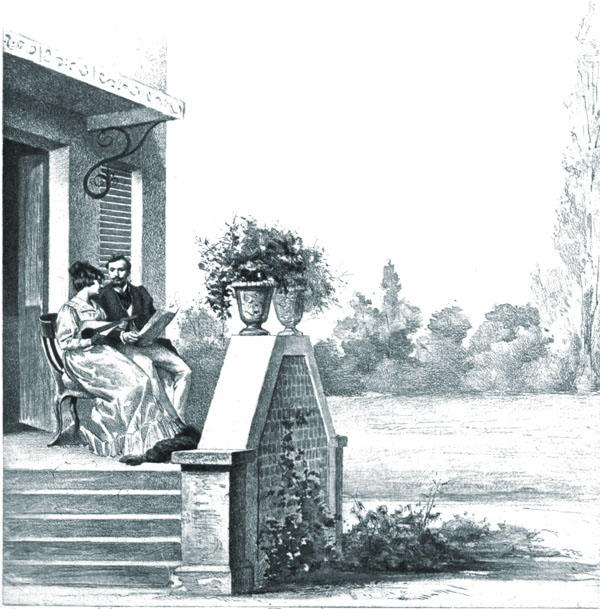
There rises on my lips a song of the time which the Almanac of the Muses has bequeathed us, to the air of The Little Sailor. It will perhaps add a spice of interest to my story. “Now, listen, my friend,” as they used to say in the noble ages of chivalry. Title of the song: The Gloves.
I love the Glove, that covers quite
The rounded arm it rests upon;
I take it off, with what delight,
With what delight I put it on!
If true it is through mystery,
A lover’s bliss will higher move,
How dear that little hand should be
Which hides itself beneath a Glove!
But there’s another Glove, whose use
Will every swaggerer displease;
A Glove correcting all abuse,
Which brings the braggart to his knees;
How many boasting folk I’ve known,
Who would, and wisely, rather prove
A flight from out the window thrown,
Than see before them that same Glove!
The Gloves are useful when we seek
The fair, the great ones, as we know;
When unto those with Gloves we speak,
Easy at once their favours grow.
They for intriguers wealth have won,
No fools their uses are above;
Of what another man has done
They boast, and give themselves the Glove.
One last couplet, I pray you, and the authoress, Madame Perrier, will bow herself out:—
The Gloveless man can ne’er afford
To dance, no step he makes with grace;
The servant wishes that his lord
Should put on Gloves in many a case.
When the police are wide awake,
To cheat those eyes they hardly love,
How many thieves will wisely take
The greatest care to wear the Glove?
The song is not so bad, truly; and if the Muse gloves the author a little tightly, the tone of his strophes is none the less strictly respectable and proper.
Under Louis XVIII. and Charles X. long Gloves were very costly; still, no coquette hesitated to change them every day, for it was necessary for them to be of extreme freshness of colour, which was either buff, gridelin, or white. Some years later, the fashion tended to maize, straw, or nut colour for the evening and morning toilet, and to palisander, burnt bread, cedar, fawn, for afternoon visits. Yellow Gloves had an infinite scale of tones, from a soft and delicate unbleached lawn colour to the glaring yellow of a stage-coach. White doe-skin was only used by men when riding.
It was about this epoch, if I mistake not, that the denunciation of Gant jaune (yellow glove) became synonymous with petit-maître (dandy). In London, the disciples of Brummel—of the most refined elegance—constituted a society, and formed the Club of the Fringed Glove. This club no longer existed doubtless in 1839, when d’Orsay established thus despotically the rules of the perfect gentleman:
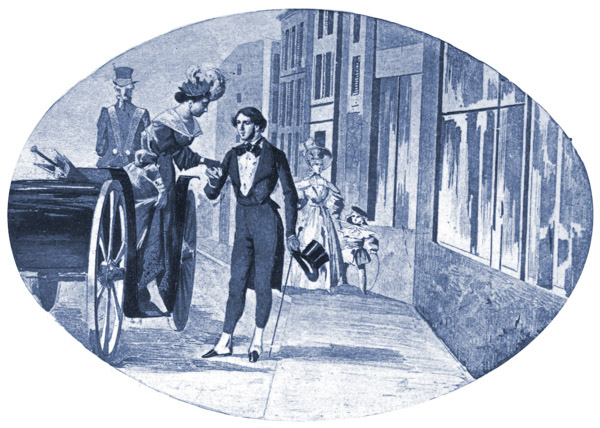
“An English gentleman of fashion,” said he, “ought to use six pair of Gloves a day:
“In the morning to drive a britzska to the hunt: Gloves of reindeer.
“At the hunt, to follow a fox: Gloves of shammy leather.
“To return to London in a Tilbury, after a drive at Richmond in the morning: Gloves of beaver.
“To go later for a walk in Hyde Park, or to conduct a lady to pay her visits or make her purchases in London, and to offer her your hand in descending from the carriage: coloured kid Gloves braided.
“To go to a dinner-party: yellow dog’s skin Gloves—and in the evening for a ball or rout: Gloves of white lamb-skin embroidered with silk.”
What odious tyranny is so exacting a fashion! And how sensible was Balzac when he wrote: “Dandyism is a heresy of fashion; in making himself a dandy, a man becomes a piece of furniture of the boudoir, an extremely ingenious puppet, which can pose on a horse, or on a sofa, which sucks habitually the end of a walking-stick, but a reasonable being—never!”
It is, however, with some dandy of the school of Rubempré and Rastignac, that often, on quitting the ball, an author shows us a romantic young lady in love, whose jealousy gnaws at her heart, who re-reads the letters of old times, and with wandering looks, like one overwhelmed, nervously tearing with her teeth a finger of her Glove, sadly dreams that the lover who is no longer all, is nothing, and that the moralist much deceived himself who wrote: “Woman is a charming creature, who puts off her love as easily as her Glove.”
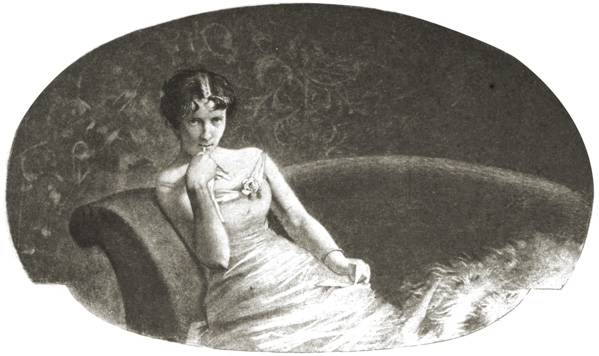
How many things are there, look you, in a Glove!
In the novel The Lion in Love of Frédéric Soulié, Léonce signs the register of marriages at the mayoralty with a gloved hand; and when Lise’s turn comes, the young girl stops, saying in a voice tinged with just a touch of mockery, “Pardon me, let me remove my Glove.”
“Léonce understood,” then says the author, “that he had signed with his gloved hand.” Sign an act of marriage with a Glove! Léonce meditated a little, and said to himself: “These people have certain delicacies. What difference makes a Glove more or less to the holiness of an oath, or the signature of a document? Nothing assuredly; and yet it seems that there is more sincerity in a naked hand, which affixes the signature of a man in testimony of the truth. It is one of those imperceptible sentiments of which we are unable to give an exact account, but which nevertheless exist.”
The fact is, that the Glove is not really, as has been said, a tyrant of which the hand is the slave, but quite the contrary—it is the hand’s servant; and with the hand, as Montaigne wrote, “We request, promise, call, dismiss, menace, pray, supplicate, deny, refuse, interrogate, admire, number, confess, repent, fear, shame, double, instruct, command, incite, encourage, swear, witness, accuse, condemn, absolve, injure, contemn, distrust, track, flatter, applaud, bless, humiliate, mock, reconcile, recommend, exalt, feast, rejoice, complain, sadden, discomfort, despair, astonish, write, suppress,” &c.
I stop out of breath: verbs of every kind may pass into the list.
With the Egyptians, the hand was a symbol of force; with the Romans, a symbol of fidelity. We please ourselves in clothing the occult powers, such as Time, Nature, Destiny, with a human hand: the hand of Time overthrows empires, and impresses wrinkles on our brows; the hand of Nature is prodigal to us of gifts, which are ravished from us by the hand of Death; the hand of Destiny or of Providence, in fine, conducts us across the paths of life.
Old stereotyped language, which we use, and shall use always. Are we not, as Saint Evremond said, in the hands of love, as the balls in the hands of tennis-players—and the first happiness which love can give, is it not, according to Stendhal—and all the truly sensitive—the first pressure of the hand of the woman we love?
Our ancestors swore by the hand, and read in the hand the mysteries of the future. On the day of coronation, the hand of justice was borne before the kings; the hand is used in salutation; we ask for the hand of the lady we wish to espouse in lawful marriage; we wash our hands, like Pontius Pilate, of faults which we could not help committing; and if I were to have to make for you the panegyric of this organ, I should have, like Scheherazade, to put off the end of my discourse every day till the morrow. Sir Charles Bell, in his book, The Hand: Its Mechanism, etc., has given a synthesis of all I could possibly add, and has proved that the human hand is so admirably formed, possesses a sensibility so exquisite, that sensibility governs with so much precision all its movements, it answers so instantaneously to the impulses of the will, that one might be tempted to believe that it is itself its seat. All its actions are so energetic, so free, and withal so delicate, that it appears to have an instinct apart; and neither its complication as an instrument is ever dreamt of, nor the relations which subject it to the mind. We avail ourselves of the service of the hand, as we perform the act of respiration, without thinking of it; and we have lost all remembrance of its first feeble efforts, as of the slow exercise which has brought it to perfection.
The hand, in a word, is the most perfect instrument given by God to man; but I ought not to forget, my fair friend, that poets seldom wear gloves, and philosophers never; and that, philosophising as I am, I remain outside the Glove, and, above all, appear to forget that axiom of Fontenelle: Had we our hand full of authenticated facts or truths, we should but half open it, and that after a feeble fashion.

The Glove is worthy of entering into the legend of a fairy tale, and remaining there always, as the slipper has entered into the poetry even of fable, with the theme of Cinderella. An ancient King of France was indeed in love all his life with an unknown woman, only from having seen her Glove in the midst of a masked ball given to his court. Could it not easily be conceived according to the approximative aphorism, “Show me your Glove, I will tell you who you are.” At the opera ball, in the surge of masks and of dominoes, in the midst of the comings and goings on that staircase so exalted, it needs but a Glove imprisoning a little hand to allure at once the passion of a man of delicacy—a long white Glove lovingly glued to a hand divinely small, a fine delicate wrist, and the exquisite roundness of the forearm. This is enough to transport a lover of the fair sex. The Glove appears not only in all festivals where grace and beauty preside; it is found in all the rudeness and clumsiness of its origin at the Poles, among the Norwegians, the Laps, and the Fins, who wear huge Gloves of wool in summer, and thick Gloves of reindeer skin, with the hair outside, in winter.

Defended by these Gloves, they sometimes sally bravely from their huts, in spite of the cruel frosts, to kill the white bear and the seal, just as the dramatic engravings which illustrate our stories of voyages to the North Pole represent them to us.
But methinks your eye is asking me in disquietude about two little bound books which I have in my reach. Reassure yourself, these are not recitals of tourists, which are for painting us the manners of the inhabitants of Karasjok or of the Lofoten Isles: I will read to you at once, without allowing you to languish any longer, their titles. Upon one of these works, see for yourself Collection of the Best Riddles of the Time, composed on divers serious and sprightly subjects by Colletet; on the other, Collection of Riddles of the Time, by the Abbé Cotin. You already divine that I intend to act no traitor’s part towards you, and that I am going to read you some old charades in verse upon Gloves:
The first riddle—énigme has been masculine in French at least since the seventeenth century, in despite of its profound femininity—the first riddle, in obscure and ambiguous terms, indicates that the Glove, after having been the natural covering of a rustic animal, serves to-day as an artificial covering for an animal more refined: man!
We’re two or ten, and to a body wed,
We once a thing of breathing life were over;
Like it we lived, and now, although we’re dead,
Another life more excellent we cover.
This quatrain riddle is by François Colletet, that poor poet up to his neck in mud. Listen now to Cotin—the Trissotin of Molière—in this singular sextain:—
With mortal flesh our five soft mouths we fill,
And in the winter to repletion feed;
If one of us be lost, the world’s agreed
To treat the rest of us exceeding ill;
But if we all remain together, then
We do almost all that is done by men.
Mediocre, isn’t it; tortured, bombastic, gross, all at once? There is nothing here to make us fall into an ecstasy, and repeat to satiety, as some highly refined courtiers used to do, “Ah, with what congruity of terms are these thoughts expressed!”
I shall abandon the riddles at once. These two specimens are enough. Another point:
Many physiologists affirm that great warriors have been remarkable for a beautiful hand, which they loved perhaps to adorn with the most delicate gloves. They instance Cyrus, Alexander, Cæsar, Charlemagne, and Napoleon.
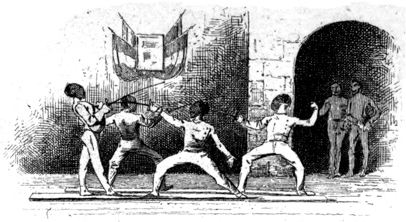
According to an historian of the First Empire, some generals attending Bonaparte one day in his private room, found his big military Gloves and his little hat on a side-table. Actuated by curiosity, each one of them tried in turn the Glove and the hat; but it appears there was not a single hand which could force its entrance into those big Gloves, and upon those giants’ shoulders not a single head which could fill up the little hat.
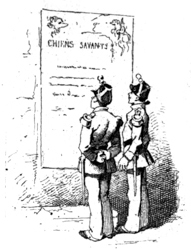
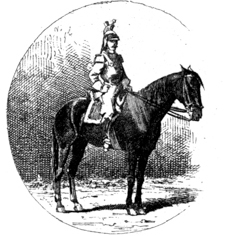
Napoleon was, it is weil known, no less proud of his hand than Byron, who, his biographer tells us, had a hand so small, that it was out of all proportion with his face. Byron thought and wrote that nothing characterised birth more than the hand; it was, according to him, almost the sole index of aristocracy of blood.
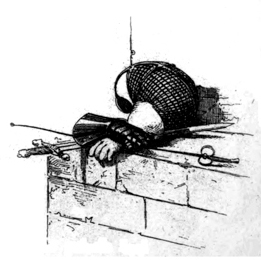
Since the fifteenth century, we can trace in the museums of France, Holland, Italy, Spain, and Germany, the interest which painters of all schools have taken in the study of the hand, and, indeed, of the Glove. Van Dyck and Rubens were passed masters in this art, and Titian has left an admirable masterpiece in his Young Man with the Glove. Velasquez almost always makes his powerful models hold Gloves, nobly folded in their right hand. In Venetian paintings we see the Glove on the hands of the Doge, of his wife, of ambassadors, of senators, of residents, and even of merchants. The mere study of the Gloves in these portraits and these costumes would suffice for a long pamphlet, for we must consider the Glove in all classes of society and in all epochs, from the embroidered Gloves of the Doges to the special Gloves of the merchants, of the rectors of the university of Padua, and even of the monks of the brotherhood of the Cross, which were violet on a white ground, &c.
But it would be madness to endeavour to omit nothing in this monograph of the Glove, a tentative work, and an unpremeditated sketch of little pretension.
Have we not still to consider the stuffed fencing Glove, with the short shield of red leather, and the giant Glove which swells the fist of the boxers?—the ordinance Glove of the good Dumanet; that white cotton Glove which the brave trooper puts on so willingly on Sunday, coming out of barracks like a conquering hero? Is there not besides the Glove of the Cuirassier, with its large shield of buckskin, which this last man of iron places so gallantly on his hip when he is on express service?
The history of Gauntlets and of military Gloves from the time of the Middle Ages would make a mighty volume, like the ladies’ Glove and the work-people’s Mitten. The liturgical Glove, yet more important, is of three kinds: the pontifical Glove, which was worn by bishops and abbés; the Glove which simple priests had adopted for particular occasions; and lastly, the prelatic Glove. On pontifical Gloves alone Monseigneur X. Barbier de Montault has found means to write in the Bulletin Monumental, 1876-1877, nearly two hundred pages of closely packed text, in 8vo: Ab uno disce omnes. See, my amiable friend, I repeat it—see in what an inextricable archæological labyrinth I might have set you to wander, à propos of all these dear little Gloves, of which I had promised you a history, but about which it appears to me I am making only a lively chatter of whipped Glove. I should not have set on the table aught beyond that which lends grace to woman: Gloves on a champagne glass or in a shepherdess’s hat, roses and a love-letter half opened; such simple still life had assuredly better inspired my Muse than all the documents brought together and packed one on another, well calculated to frighten a mind which is by no means pleased with such barricades of notes and annotations. Ah, my fair friend, how right was Balzac, in his brilliant and profound Traité de la vie élégante, when he wrote the following lines, which I had not sufficiently considered before pledging my word in your society!
“The learned man, or the elegant man of the world, who would search out in every epoch the costumes of a people, would compile the most interesting history and the most rationally true. . . . . To ask the origin of shoes, of alms-purses, of hoods, of the cockade, of hoop-petticoats, of farthingales, of Gloves, of masks, is to drag a modilogist into the frightful maze of sumptuary laws, and upon all the battlefields, where civilisation has triumphed over the gross manners imported into Europe by the barbarism of the Middle Ages.
“Things futile in appearance,” continues the author of the Théorie de la démarche, “represent either ideas or interests—whether it be bust, or foot, or head”—he might have said, above all, or hand—“you will ever see a social progress, a retrograde system, or some desperate struggle formulating itself by the assistance of some part or other of the dress. Now the shoe announces a privilege, now the hat signals a revolution—a piece of embroidery, a scarf, or some ornament of straw, is the sign of a party. Why should the toilet be then always the most eloquent of styles, if it was not really the whole man, the man with his political opinions, the man with the text of his existence, the hieroglyphic man? To-day Vestignomy has become almost a branch of the art created by Gall and Lavater.”
I am overwhelmed, O my indulgent friend! I feel that I have been far inferior to my task, and I fear I have not had that charming art of saying nothing which often says so many things. I have neglected to show you the Glove in princely Inventaires, in the old chronicles, and in the delightful tales of Boccaccio, of the Queen of Navarre, of Straparole, of Bonaventure Desperriers, and even in Brantôme, who has written a little story, full of old French esprit, on a Glove found in the bed of a fashionable lady. I had a good opportunity of showing you the anecdotic Glove of ever so many romances and memoirs from Le Petit Jehan de Saintre up to Casanova the Venetian, going through l’ Histoire amoureuse des Gaules.
But the natural and the unpremeditated is also a French quality, of which we must sometimes allow the grace, even in recognising its defects. I left the history of the Glove, I believe, in 1840; and I do not suppose that I have painted for you all the little cuffs, festoons, ruches, notchings, indentations, which adorned the fastenings of the town Gloves of our elegant ladies, nor the long black mittens which accompanied the blonde bodices, of which in those modest times people were madly fond. It is of little consequence for me to follow the fashions from 1840 to the present day: one cannot be a woman and remain ignorant of these different variations of a fashion of which all the specimens return periodically to reconquer a second of celebrity. Open-worked Gloves of Chinese silk, Spanish Gloves, Beaver Gloves, Swedish Gloves, glacé kid Gloves, musketeers’ Gloves, Colombine, with cuffs—what do I say?—the qualifications are innumerable; they change still more than the fashion, for the epithet gives a springtide and deceives the customer—a fortiori would it deceive the Gantuographer, if you will allow me this hideous neologism.
That which I have not been able to accomplish, that which you have not demanded of me, that which nevertheless would have interested you far more than this sleepy talk, is the Physiology of the Glove, with this epigraph taken from an anonymous but witty author—“The style is the man; the Glove is the woman; the style sometimes deceives, but the Glove never.”
I am launched, don’t you see, into theories historic, philosophic, and, above all, physiognomic, in a study altogether beside the mark?
Allow, my sweet and somnolent one, that if you had permitted me at first to take this part (which for my slight notice was assuredly better), I should have been less clumsily stiff, less dull above all, less pretentious besides; albeit I make no other pretension here than to do your pleasure. You have thrown me the Glove on the confines of history; it is thence that I have raised it with more effeminancy than swagger.
I could have wished that fancy might have dictated to history; but, in the present case, it is the most that has been done, if history has succeeded in warming the amiable fancy, which has not taken Gloves to make us villainously sulky with each other.
Pardon!—indulgent interlocutress!
Excuse also, amiable lady readers, ye who read this congealed babble, and who have yet less reason to be favourable to me, in this sense, that to you all, alas! I cannot say, as was once said in the polite world—Friendship allows the Glove.
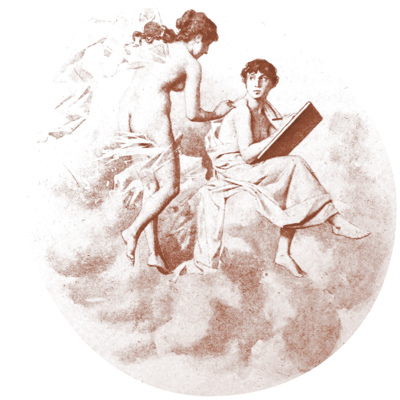
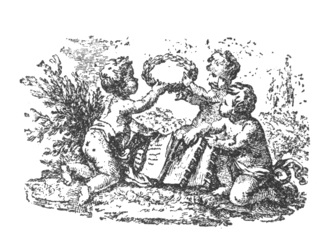
THE FUR.
 THE Muff! The very name has something about it delicate, downy, and voluptuous. From that little warm satin nest, where pretty chilly little hands ensconce themselves in silk, carrying with them a lace handkerchief, a box of lozenges, a bouquet of Parma violets, or a tender loving billet-doux, a thousand trifles spring up to please us, like a swarm of souvenirs and caressing thoughts of our first years passed at home, and of our first roving loves.
THE Muff! The very name has something about it delicate, downy, and voluptuous. From that little warm satin nest, where pretty chilly little hands ensconce themselves in silk, carrying with them a lace handkerchief, a box of lozenges, a bouquet of Parma violets, or a tender loving billet-doux, a thousand trifles spring up to please us, like a swarm of souvenirs and caressing thoughts of our first years passed at home, and of our first roving loves.
In childhood, we delight to play with the large maternal Muff, to pass our hands over it the wrong way to excite the electricity of the long hair, to plunge our faces in the pungent heady odour of its down, and to make use of this furred sack in inconceivable tricks, in playing at hide-and-seek with small objects, or in burying therein the familiar cat, who becomes lazy in its warmth.
Then, later on, at the hour of the first rendezvous, during one of those icy winters which Ronsard dreaded for his darling, when we see our so much desired mistress appear veiled and all imprisoned in furs, we become almost jealous of the pretty and coquettish Muff, in which she buries her roguish little nose, which the glacial breeze has lashed and reddened, and we plunge then with a sweet brutality our own hands into the silky cylinder, there to find, and there passionately to press the pretty idle fingers, which we are for so generously thawing, by covering them with long kisses like gloves.
When the Muff returns from exile with the first hoar frosts of November, it causes, as soon as it appears on the boulevards, a sensation, intimate and delicious, to all true feminists, to the Dilettanti of woman—to all those who perceive in their most delicate shades the graces of which a naive or coquettish woman can avail herself, whether in handling the Fan or the Sunshade, or in tucking up a corner of a spring petticoat, or in passing along radiant in a long furry pelisse, or more passive in letting herself glide languishingly in a sledge over the ice of the lake, making eyes at her darling who skates by her side, and pushes forward her coquettish equipage. It seems that woman, that exquisite and delicate flower, blossoms in fur, as those white gardenias of the conservatory which half open and develop themselves in a nest of perfumed wadding.
The more she hides, muffles up, deadens, so to speak, her beauty, the more woman—a creature of Hades who makes us dream of paradise—is bewitching in the diabolicity of her graces. When Love, who is represented blind, sets a mask on Venus-coquette, one might think the trickster boy was for burning the universe, for behind those yawning apertures of the black velvet mask, behind those murderous loopholes, two woman’s eyes are lying in ambush, pitiless, turn by turn laughing, burning, blazing, drowned in pleasure, charged, in a word, as with grape-shot, with all the shafts of the Cupidonian quiver.
Thus, out of the midst of furs, woman, that mignonette plant, that mimosa pudica, throws off beauty more mysterious, more warm, more full of promise, more enveloped and more enveloping, as if from the electricity of that peltry, there was spread in the ambient air of the provoking daughter of Eve an attractive sensuality, like a subtle caress, which rustles against our senses in its passage.
The ancients had perhaps great reason to attach, as they did, certain excellences and prerogatives to fur: a master furrier, Charrier, wrote on this subject, in 1634, remarks and moral considerations as naïve as curious: “Our kings, whether they are consecrated, crowned, or married, divest themselves of the splendour of embroideries and of diamonds, to take their royal mantle hedged about with lilies and lined with ermine.
“The mantles of the chevaliers, dukes, and peers of France are lined with lynx, marten, and ermine; the chancellors, keepers of the seals, who are the guardians of our laws, wear the most exquisite furs.
“Bachelors and doctors, emperors and physicians clothe themselves with furs which represent the mysteries of theology, the maxims of politics, the secrets of medicine. Furs cure people of headaches and disordered stomachs; attacks of gout which triumph over the most potent remedies, are vanquished by the skins of cats, lambs, and hares.”
In fine, the good Charrier proves with pride that of all the ornaments which luxury has invented there is none so glorious, so august, so precious, as furs, and that the privileges of peltry merchants rightly surpass those of all others.
The masters and wardens of the peltry merchandise had for their arms a paschal lamb on an azure field. Two ermines supported the shield crested with the ducal crown, with this device in exergue—very like that of Brittany—Malo mori quam fœdari.
The use of furs dates back to the origin of the world. Plutarch, in his Table Talk, relates that people dressed themselves in skins before they became acquainted with stuffs. Tacitus assures us it was the same with the Teutons, Propertius with the Romans.
Robed in rich silk, the Court you now behold
Was once a folk fur-clad against the cold,
says a poet of the sixteenth century. But without stopping at the conquest of the Golden Fleece, at Rebekah ordering Jacob to put on his hands and neck kids’ skins, at all the examples of the Bible and of history, we will only remark that the four noble furs consecrated by feudality were the ermine, the vair, the sable, and the miniver. The colours of furs admitted into coats of arms were those of the sable, the ermine, and the vair.
Charlemagne, who loved, they say, simplicity in his apparel, had, according to Eginhard, the habit of wearing in summer a mantle of otter’s skin; but in winter he covered himself with a mantle of which the sleeves were lined with vair and foxes’ fur. This is corroborated by the four following verses of Philippe Mousnes, the poet biographer of this Emperor:—
But in the days of fallen leaves,
He wore a new surcoat with sleeves
Of furs of foxes and of vair
To shield him from the nipping air.
At the epoch of the Crusades, the luxury of furs was carried to the highest degree in Western Europe; but to remain absolutely fixed to the Muff, we must register the first apparition of this little fur about the end of the sixteenth century. In the inventory of goods left by the widow of the President Nicolai we read: Item, a Muff of velvet lined with marten.
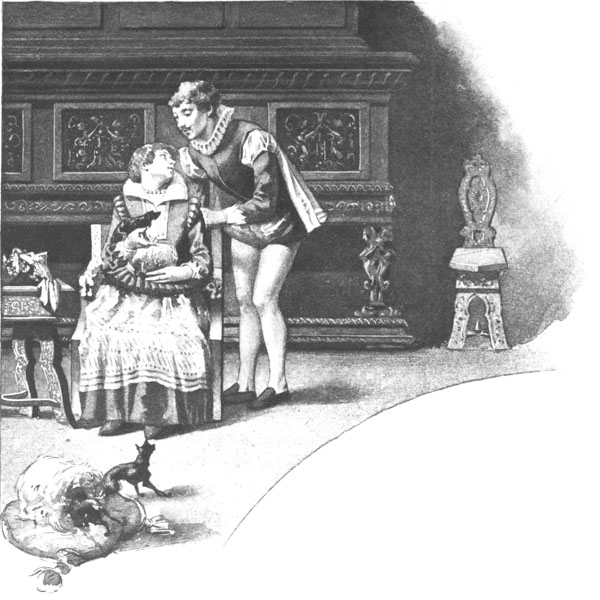
In Venice, however, we have in our researches found a vestige of the Muff at the end of the fifteenth century; celebrated courtezans and noble ladies at that time carried Muffs, which served for niches to minuscular dogs; and an engraving represents a scene of an interior, in which a fair Venetian seems to be showing her lover the infinite games of her lap-dogs in her Muff.
There were at that time in Venice delicious Muffs made after the primitive fashion of a single band of velvet, brocade, or silk, lined with fine fur, rounded in a cylinder, of which the extremities were closed in different widths by buttons of orient crystal, pearls or gold.
D’Aubigné, in his Universal History, says in the course of a story of a besieged town:—“The inhabitants descended thirty paces from the breach, and among the foremost was noticed a woman with Muffs, a halberd in her hand, who mixed with and distinguished herself in this combat.” Under the designation of Muffs we must understand here spare half-sleeves like those mentioned in the Library of Vauprivas à propos of Louise Labé. Under Charles IX. the simple citizen folk were only allowed to wear black Muffs; ladies of the highest condition had alone a right to sumptuous Muffs of various colours.
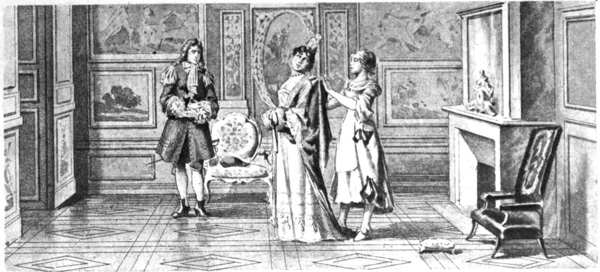
In a satiric print of 1634, signed Jaspar Isac, and entitled The Squire à la Mode, we see carried by a woman, who is accompanied on foot by a Gascon cavalier, the first French Muff having a direct relation with that which is still in use at the present day. It is a sheath of stuff or silk bordered on both sides by a thick white fur, which grows into an enormous roll at the ends.
But it is amongst the precious engravings of Hollar, Abraham Bosse, Arnoult, Sandrart, Bonnard, and Trouvain that we see the authentic Muff really born, and find it in the hands of the Parisian matron, of the lady of quality in her winter dress, of the Précieuse, and the coquetting flirt. An engraving of Bonnard shows us a great lady with her head dressed à la Fontange, and in court dress, on the point of going out; a waiting-maid adjusts her mantle, and a gentleman attends the beauty’s good pleasure; the Muff she carries was then of a moderate size, with a bow in the middle. The Muff was worn for style, “for grace,” and was made of sable-marten for ladies of the Court, and simply of dogskin or catskin for the small citizens’ wives who could not devote more than fifteen to twenty francs to the acquisition of this light hand-warmer.
Antoine Furetière, in his Dictionary, has condensed in a few lines all the materials of a Dissertation on the Muff of the seventeenth century. At the word Muff we read:—
A fur worn in winter, in which to put the hands, to keep them warm. Muffs were formerly only for women: at the present day they are carried by men. The finest Muffs are made of marten, . . . . the common of miniver; . . . . the country Muffs of the cavaliers are made of otter and of tiger. A woman puts her nose in her Muff to hide herself. A little Muff-dog is a little dog which ladies can carry in their Muff.
Everything we see is summed up in this. Saint-Jean and Bonnard have preserved for us types of French gentlemen bearing the Muff under Louis XIV. One, in court dress, carries with much grace a small spotted Muff, which he holds in one hand, showing a glimpse at the unoccupied end of the cuff of a fur glove; another, in winter court-dress, holds with the languor of a petit-maître a pretty plump otter Muff falling to the hips, giving a gracious curve to the arm; in the middle of this Muff a vast bow of ribbons or Galants, something like the old trimming called petite oie, is displayed with an excellent effect. In 1680, nothing, according to the Mercure Galant, was to be seen but ribbons purfled with gold, laced, fringed, wreathed, purled, or embroidered, which were gathered in a bow in front, of the Muff.
La Fontaine alludes doubtless to the country Muff spoken of by Furetière when, in the fable of the Monkey and the Leopard, he makes the latter say:—
The king desires me at his Court,
And must have—if I die for’t—
A Muff, made of my skin, so full of blots
Of colour, and of lines, and dots,
And dappled stains, and chequered spots.
As to the Muff-dog—to finish the registration of the definition of Furetière—not only has Hollar left us an engraving of it, and presented it to us under the form of a small Spaniel, but Father du Cerceau makes his upholsterer poet say—Even the lady’s lapdog barked at me, that ingrate
Cadet, for whom I used to stuff
So many sweets inside my Muff.
The chief hall of the peltry merchants and furriers of the 17th century, in Paris, was in the Rue de la Tabletterie or Rue des Fourreurs, which led into the cross-way of the Place aux Chats. The shops of the retail peltry merchants were nearly all situated in the City, Rue Saint-Jacques de la Boucherie, and Rue de la Juiverie.
“In these places,” says Léger, “are to be found very beautiful Muffs for men and for women, and very fashionable ones . . . there are to be sold also very beautiful amices of miniver.” He adds a word about the Palatines properly got up, composed of skins of animals, foreign and native. The Livre commode des adresses de Paris contains some designations of peltry merchants and furriers towards the end of the seventeenth century.
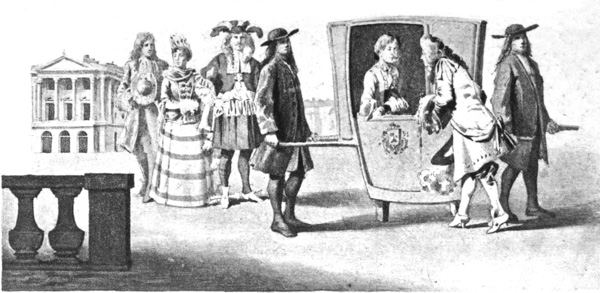
Fashion altered the shape of the Muff considerably under Louis XIV. From the rare documents which we have been able to catalogue, we have easily found numerous modifications in both form and volume. Sometimes narrow and long, sometimes broad and short, it would be impossible to assign to this little chattel an exact type for all that epoch.
The Muff triumphed already, under Louis XIII., in the empire of oglings and at the Place Royale, as it reigned later at Versailles, and showed itself in sedan chairs in the midst of the alleys of the park at the visiting hour, lending always to woman a charming countenance and exquisite graces.
Scarron, in his Poésies Diverses, has left us in four verses a pretty picture of manners for any one who could morally develop it. The poor cripple Scarron certainly had no need of a Muff in his arm-chair!—
My wife then leaves at once, though she
All perils should divide with me;
She takes her Muff and goes
To see some one she knows. . . .
But let us leave the age of big wigs and Fontange head-dresses, and penetrate into the age of powder and patches, into the age of Voltaire, who, à propos of one of his characters in Micromégas, wrote:
“Imagine a very small Muff-dog following a captain of the Guards of the King of Prussia.”

An engraving of the Encyclopédie presents us in the nick of time with a faithful reproduction of a shop of a furrier of the last century. Day penetrates through a large glass bow window; all round, on shelves, are ranged Muffs and different furs; two pleasing shopwomen offer their customers enormous Muffs of miniver, and a shop-boy beats with a rod one of those furred mantles which were sent “to be kept” during the summer, to preserve them from the mites. This engraving, a precious document which may be attributed to Cochin, recalls two charming little stories of Restif de la Bretonne in his Contemporaines du Commun: one entitled La Jolie Fourreuse, the other La Jolie Pelletière. Professions passed out of sight!
“Furs”—MM. de Goncourt wrote in a note of much study to their book La Femme au XVIIIe Siècle—“were a great luxury of Parisian ladies, at the time when the fashion was to arrive at the opera wrapt in the most superb and rarest, and to take them off little by little with coquettish art.” The reputation of the sable, the ermine, the miniver, the lynx, the otter, is indicated in the Étrennes Fourrées dédiées aux jolies Frileuses, Geneva, 1770. Muffs have quite a history, from those on which the furrier brought discredit, in causing one to be worn by the hangman on the execution day—these were probably Muffs à la Jésuite, muffs which were not of fur, and against which a pleasantry at the commencement of the century, A petition presented to the Pope by the master furriers, solicits excommunication—up to those of Angora goats’ hair, immense Muffs which reached to the ground, and to the little Muffs at the end of the century, baptized little barrels, as the Palatine was called cat. The fashion of sledges, then very widely spread, added to the fashion of furs. An etching of Caylus, after a drawing of Coypel, about the middle of the century, shows us in a sledge set on dolphins—one of those sledges which cost ten thousand crowns—a pretty woman dressed entirely in fur, her head-dress a small bonnet of fur with an egret, carried along in a sledge, which is driven by a coachman dressed like a Muscovite, and standing at the back. À propos of furs, the Palatine owes its fortune and its name to the Duchess of Orléans, mother of the Regent, known under the name of the Princess Palatine.
Palatines—which were made of fox, of marten, of miniver—were worn for a long time with Polonaises and Hongrelines. Roy, a French poet of the 18th century, who made acquaintance with the stick at different intervals—sent some bad verses to a lady on the subject of her blue palatine. The Almanach des Muses of 1772 has preserved them for us. Here they are:—
That charming colour wear,
The colour of the summer sky above,
The colour Venus sets on every Love,
Which makes the fairest faces yet more fair,
As Venus in her own sweet self can prove:
But the white place where falls the tufted bow
Is nought indeed but lovely nakedness;
Why hide it then? The beauty which men bless
Gains on the whole by losing, don’t you know?
Caraccioli remarks that people used Muffs in winter just as much for elegance as for need. “The form varies continually,” he says; “to-day (1768) men carry small Muffs lined with down, and trimmed with black or grey satin.”
In 1720, women’s Muffs were very narrow and long; the crossed hands filled it exactly; afterwards they became wider, like those we may see on the hands of the pretty skaters of Lancret. A typical Muff of the epoch was the ermine Muff, fearfully large, which we find carried by the Venetian masks of the delicious Pietro Longhi, who seems to have wished to illustrate by his pictures the Memoires of Jacques Casanova of Seingalt. In the small engravings of the century relating to travelling, which show us the stoppages at the inn, or the packings in the public vehicles, we see everywhere the feminine Muff delicately pressed against their waists by the pretty adventuresses. Boucher’s skater, who passes like a gracious Parisian little figure over a background of a Dutch landscape, doubled up but valiant, appears to make a prow of her Muff, the better to cleave the sharp cold air. But in the intimacy of private life, in the eighteenth century as now, the Muff could lend a charm to genre paintings, and the manufacturers of prints might have composed many Little posts and Nests for love-letters, interpreting by their drawing what the author of the Dictionnaire des Amoureux wished to express, when at the word Muff he gives this piquant definition: A Letter-box, lined with white satin.

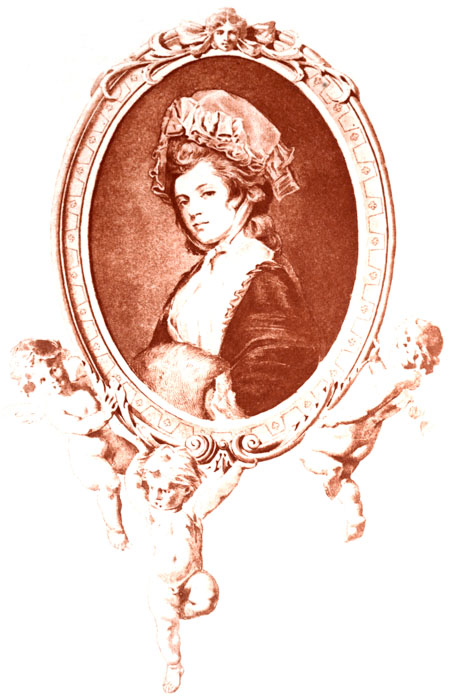
The most celebrated and the most delicious picture in which a Muff figures is assuredly that adorable painting known by the name of The Young Girl with the Muff, by Joshua Reynolds, which formed part of the beautiful collection of the Marquis of Hertford. Nothing is more delicate than this painting. That young English-woman seems rather to walk through the picture than remain fixed in it, so great, one might say, was the quickness with which the painter has caught that image in its passage with its movement of walking—the body is inclined a little forward, the head on one side; the woman’s bust, which stops at the Muff, is so fresh in its composition, so fine in its tonality, so radiant in its originality of design, that it would be enough almost by itself to establish the immortal reputation of Reynolds, who has put into his work a very quintessence of femininity, as an ideal of the most exquisite English loveliness, and also as a type, delicate and never to be forgotten, of a chilly beauty.
Nor must we forget the Portrait of Mrs. Siddons, painted by Gainsborough, in the charm of her twenty-ninth year, in 1784. This picture, which was exhibited at Manchester in 1857, is now in the National Gallery. The charming lady, dressed in a fresh striped blue and white robe, with a fawn-coloured shawl half falling from her shoulders, has on her head a large black felt hat, ornamented with feathers—one of those hats which have done more for the vulgarisation of the glory of Gainsborough than all his studies and portraits. Mrs. Siddons is seated, holding on her lap with her left hand a comfortable Muff of fox or Siberian wolf, of which she appears to caress the fur with her right hand, as if to show off the beauty and whiteness of her spindle-shaped fingers. The mistress of the works of a master who had, it is only right to say, the most ravishing face in the world to portray. But, without needing to have further recourse to the English school, have we not that luminous portrait of Madame Vigée Lebrun, in which the Muff, raised almost level with the head, spreads the shine of its hair of tawny gold like the head of a courtezan of Venice? That astonishing painting of the end of the eighteenth century appeared in its dazzling splendour, in the midst of the square saloon of the Museum of the Louvre, killing, by mere force of freshness and light, the magistral bituminous pictures of the beginning of the century, which are its near neighbours.
Under Louis XVI. the frenzy of the toilette reached its most acute crisis: fashions succeeded one another in a few years with so much rapidity that we can scarcely follow them; people sought to outstrip in everything rather than to refine, and the Muffs, carried by men and women alike, became enormous and exaggerated. Hurtaut, in his Dictionnaire de la Ville de Paris, article Modes, makes this strange remark in the year 1784, “A lady has been seen at the opera with a Muff of momentaneous agitation.”
The intellect loses itself in seeking the exact definition of this qualificative of momentaneous agitation!
In 1788 a fashion was Muffs of Siberian wolf. According to the Magasin des Modes Nouvelles Françaises et Anglaises, the young folks no longer carried their Muff after the peaceable and good citizen-like fashion à la papa level with the bottom of the waistcoat; they used it, on the contrary, like a plaything or an opera hat; they held it in their hand while gesticulating in their promenades, or carried it under their arms like a portfolio strangled and crumpled between the elbow and the chest.
The little dogs, the Muff-toy-terriers, which had continued in favour since the Regency, were more in request now than ever; every woman of fashion had her pug and her King Charles’ pet, like those small dogs that now come from Havanna.
In the celebrated coloured engraving of Debucourt, La Galerie de Bois au Palais-Royal, in 1787, we see circulating in the midst of that strange crowd which was called the medley of the Palais-Royal, extravagant types, among them women holding in their hand beside their furred cloak those incredible Muffs of an immense size, which figure also under the arms of the masked gallants of the time, with a small bow of satin attached to the fur.
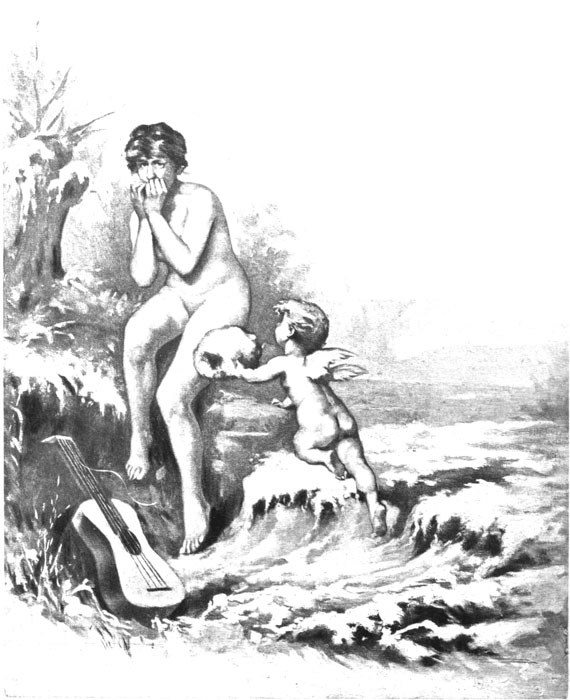
Under the Revolution and the Directory the fashion of Muffs was extremes, either broad as little barrels, or narrow and minuscular; in other respects the fashion varied infinitely, and we must come to the Restoration to find the first chinchilla Muffs which harmonised with the velvet witchouras. Absurd fashions to study! What Muff would the painter choose who wished, by way of allegory, to show a grasshopper shivering in the hoar frost and the snow, to whom charitable Love brings a downy Muff? A pretty subject for a concourse of an Academy which claimed to be précieuse and refined.
In 1835, Muffs, boas, palatines, cloaks lined with marten or fox, affected odious and indescribable forms: they used to make for a time Glove-Muffs, a sort of mittens of marten, which were soldered on to one another where the hands crossed. The Muff, that accessory of the toilet, ought to be in harmony with the general tonality and style of costume. Therefore, to undertake to describe it at that epoch would be only possible in sketching a complete history of Fashion.

The picturesque Muff of 1830 to 1850, is assuredly the big Muff of the Parisian or provincial tradeswomen, those Muffs, larders and lumber-rooms, which we meet in the deobstruent tales of Paul de Kock, and see figuring in the primitive tilted spring-carts driven by the master, in which are packed the mistress and all the assistant clerks, with a view to exploring some suburban corner on Sunday, there to laugh with their muffs pressed before their mouths, and to act a thousand follies of a doubtful taste, and to banquet plentifully, and to sing during the dessert some free-and-easy ditty, very jovial, after the fashion of those pleasant couplets of Laujon on The Muff, which I will quote here, with the more confidence, since they figure in the Chansons de Parades collected by that boon companion, who was at the same time member of the Caveau and of the Institute:—
See what it is to be too good!
One morning, leaving the warm fold
Of home, Simon I saw, who stood
And shivered in the nipping cold;
He cried, “Come here, you little pearl,
I feel so very cold, my girl!”
Now warm yourself!
Simon, good sir, ensconce yourself!
I’ll lend you, sir, my bran-new Muff!
My dear!
I’ll lend you, sir, my bran-new Muff!
“I feel so very cold, my girl!”
Ay me! I had my new Muff on.
My head was surely in a whirl
To lend it to the good Simon.
That day my kindness cost me dear;
My Muff is spoilt for all the year!
Now warm yourself!
I’ll lend you, sir, my bran-new Muff!
My dear!
My Muff is spoilt for all the year,
For Simon’s ways are rather rough;
And he knows nought of doubt or fear,
He quite destroyed my poor new Muff!
Simon, you’ve ruffled all its fur,
Made it too large, you careless sir!
Now warm yourself!
I’ll lend you, sir, my bran-new Muff!
My dear!
Made it too large, you careless sir!
See: it has been entirely spoiled,
’Tis metamorphosed, I aver;
And seems all rumpled up and soiled.
’Tis like my aunt’s Muff, all agape,
Quite out of countenance and shape!
Now warm yourself!
Simon, good sir, ensconce yourself!
I’ll lend you, sir, my bran-new Muff!
My dear!
I’ll lend you, sir, my bran-new Muff!
What laughter, what shouts, what chokings, in those parties à la Paul de Kock, when an artless maiden—at the time when pleasant digestion had set its bloom on all faces—sang, one by one, these ancient couplets, with an air at once of a whimpering girl and of a woman full of coquettish intelligence.
The Muff has not always brought tears of laughter to the eyes, and a physiologist might draw from it many a curious deduction; only to cite a single instance, in the middle of the Scènes de la Vie de Bohème, in the episode of Francine’s Muff, which should remain in every reader’s memory—the tears come into all our eyes resultant from an emotion at once sincere and profound.
Francine has been condemned by her doctor, and hears with her eyes the terrible sentence of the physician.
“Don’t listen to him,” says she to her love, “don’t listen to him, Jacques, he is telling stories; we will go out to-morrow, it is All Hallows Day, it will be cold, . . . go and buy me a Muff, . . . mind it is a good one, . . . and will last a long while; I am afraid of having chilblains this winter.”

Then, when Jacques has brought the Muff: “It is very pretty,” said Francine; “I will carry it in our walk.”
The morrow, All Hallows Day, about the time of the Angelus of noon, she was seized with the death-struggle, and all her body began to tremble. “My hands are cold, cold,” she murmured, “give me my Muff, dear”—and she plunged her poor little fingers into the fur.
“It is over,” said the doctor to Jacques, “give her a last kiss;” and Jacques glued his lips to those of his darling. At the last moment, they wished to take away her Muff, but her hands still clung to it.
“No, no,” she cried, “let it be—we are in winter, it is cold. Ah my poor Jacques!”
And so Francine dies, without quitting her Muff. A poignant and lugubrious story, like the work of Murger in general; the Muff of Francine will perhaps be the most durable chapter in the Vie de Bohème. We have not been able to set this realistic scene upon the stage, but a painter, M. Haquette, has displayed it after an admirable manner in one of his best pictures exhibited in one of the Paris annual Salons.

Truly the Muff calls up many sad thoughts for sentimental and charitable souls; this winter chattel reminds them of the sorrows of those who are without fire and home and comfortable clothing, and when the north wind blows without, and the snow falls softly in sombre silence, more than one dreaming girl, with her elbow leaning on the window-sill, lets her Muff fall while thinking of those unfortunates who suffer, of the careless grasshoppers and the laborious ants, of whom an adverse fortune has deceived the foresight.

The Muff, the mysterious Muff, hides many distresses: we see it at the present day on the hands of all the working girls and milliners, who set out early in the winter mornings from their homes for the distant workshops; and it is a load upon one’s heart to see all these miserable little Muffs made of rabbit or black cat, out of which peeps often the golden point of a penny roll and a greasy paper which envelops a chlorotic piece of pork or an Arlequin (bits of broken meat) bought in the early market. The Muff which warms so many pretty hands brave and toiling, seems in winter to be the refuge of virtue, shivering but victorious.
How much luxury is there, on the other hand, in the Muffs of the fine world during the last twenty years! They have been made very small, of sable tails, and very expensive; but there have been also some more modest, made with that marten of Australia which took the place of the Astrakhan, which passed out of fashion in 1860. They have been manufactured also in velvet plush or in cloth, with borders of fur or feathers, and a large bow of ribbons in the centre. Some became veritable scent-bags, perfumed with heliotrope, rose, gardenia, verbena, violet, or they were powdered inside with orris root or poudre à la Maréchale.
An elegant and witty lady-correspondent of fashion, who signs with the word Étincelle the notes full of charming confusion in her Carnet d’un Mondain, lately gave the nomenclature of the Muffs of the day, painted in water-colours:
“The Nest-Muff, in satin coulissé, lined with black and white lace, with a whole company of little Indian birds and frightened paroquets hiding themselves in the satin folds.”
“The Flower-Muff, very small, of ivory plush, rouge cardinal or marine blue, with bunches of roses, marigolds, camellias, and violets blossoming in the midst of a great deal of lace.”
“The Watteau-Muff for the evening: a round of Loves painted on white satin. The Coppée-Muff: sparrows sunk in a sky of black satin. The Figaro-Muff, in black velvet, entirely covered with a net of black and gold chenille: three humming-birds in a nest of black lace. The Duchess Muff: all of Marabout, imitating fur, shaded with little bows of dead satin. The Castilian, in plush, covered with point noir: an orange parroquet in the middle standing out in relief on a fan of black lace. The Minerva, in skunk or sable, with a black satin bow and the head of a barn-door owl.”
All these fashions of to-day are already fashions of yesterday, so perpetual is the inconstancy of la Mode! To-day the monkey, blue fox, beaver, swan, and ermine are metamorphosed into Muffs; to-morrow will come the furs of sable, of otter, of chinchilla, of squirrel, of marten, of wolf, &c. Women and furs change, and will change, soon and often.
Fashion is the everlasting Fairy; whether she take the Sunshade as a rod at the end of her gloved hand, or the Muff as a surprise-box or a cornucopia, she is never short of inventions, of prodigies, of follies, and of ruins; she seems to avenge herself on the moderns because the ancients gave her not divine honours, nor placed her upon the summit of their Olympus. Let, then, the head of this new and great goddess be adorned with a weathercock helmet, of which Love will furnish the magnetic arrow, and let a statue be raised to that great first French citizeness, who from Paris governs the world with so formidable a despotism, against whom none ever dreams of raising a revolt.
For us, who, à propos of the Sunshade, the Glove, and the Muff, have just cast a glance upon the museum of this female ruler, we are in a state of dread from the inconceivable variety of objects which were for an hour a woman’s pleasure, and, if we have not conducted our readers before all the glass cases of this national museum, great as the universe, or “the vastest in the world,” as all large milliners’ shops entitle themselves, it is because around the ornaments of women the fickle Loves will always dance their frenzied round, which only a madman can ever hope and wish to stop. It has been said that Fashion is woman’s only literature; if, however, our elegant ladies were condemned to study the special archæology of this literature, very soon—as in love—would they desert History for Romance.
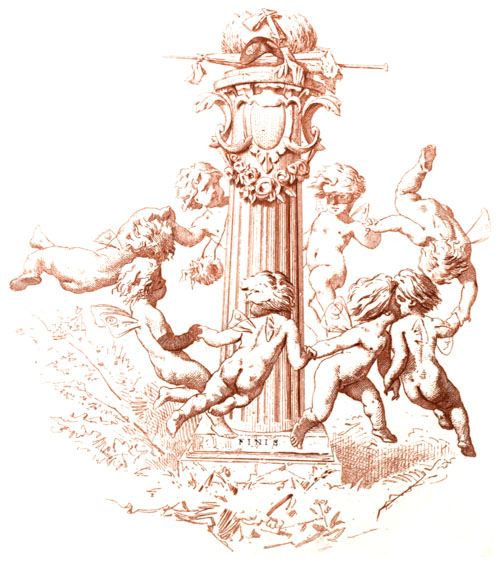
APPENDIX
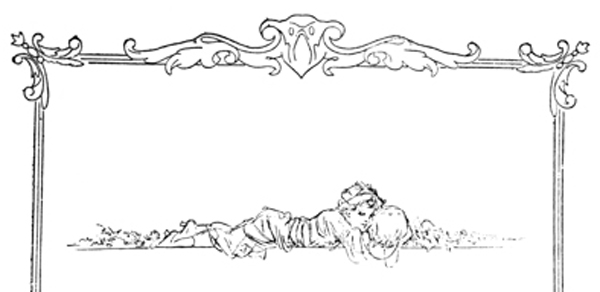
APPENDIX
![]() WE see sometimes appearing certain light little works connected either with literary history or ancient poetry, or manners and customs, which would be nothing but pretty and curious pamphlets, if the Appendix which follows them were not swelled out of all proportion with proofs and illustrations, annotated notes, documents with sidenotes, bibliographic bibliography, considerations and commentaries of all sorts, which put the reader to the torture. By this proceeding of an exaggerated literary conscience, an opuscule of thirty pages arrives sometimes at three hundred: it is in some sense a case of erudite exaltation, sometimes also a vain-glory of the investigator, who has a mind to climb up the pyramid of books he has examined, proudly there to set up his silhouette, as we plant a flag on a building as soon as it is complete.
WE see sometimes appearing certain light little works connected either with literary history or ancient poetry, or manners and customs, which would be nothing but pretty and curious pamphlets, if the Appendix which follows them were not swelled out of all proportion with proofs and illustrations, annotated notes, documents with sidenotes, bibliographic bibliography, considerations and commentaries of all sorts, which put the reader to the torture. By this proceeding of an exaggerated literary conscience, an opuscule of thirty pages arrives sometimes at three hundred: it is in some sense a case of erudite exaltation, sometimes also a vain-glory of the investigator, who has a mind to climb up the pyramid of books he has examined, proudly there to set up his silhouette, as we plant a flag on a building as soon as it is complete.
As an epilogue to another volume of this series, The Fan, we published a sketch of documentary bibliography to indicate the principal works which we had searched for the little materials necessary for that monograph. You will find there six or eight pages of titles placed without order, and ending with this phrase of a man out of breath, and expressing extreme fatigue—et cœtera.
And in this et cœtera we have set now a hundred library shelves in the shadow—sparing thus our most fastidious readers an extremely bitter pill, and sparing ourselves also the fatigues of an interminable catalogue of no great profit to any one, considering the nature of the work in question, and the fashion in which we have treated it.
At the conclusion of the three unpretending pieces of chit-chat which we have just engaged in about The Sunshade, the Glove, and the Muff, people may expect to see figuring here the lineaments or first matters of the canvas on which we embroidered our bold arabesques. People will be deceived. It will please us for this time to hide the innumerable instruments of our thefts; they are still there by our sides, making walls and barricades upon our tables and the seats round about us. But if, on the termination of a task, we love usually to put back regularly in order a library turned upside down by the fever of researches, happy in being nourished by the intellectual juice of old books, sometimes also we are prostrated by that intense discouragement which “dumfounds a man,” according to an every-day expression. In fact, the result has not answered so great a working up of material, a picture has been dreamed of too big for the frame, the artist has been obliged to reduce himself, to resign himself, and to put in nothing of his own essence; in short, the Mosaic littérateur looks at the Little Thing he has just finished beside the Great Matter which he had conceived.
In like conditions, the meâ culpâ is the sole preventive parade that can be made in his retreat to questions which become twisted into a note of interrogation on the smiling lips of the reader.
To make an inventory of the books we have consulted would be a torture worse than that of Tantalus, for desire, far from looking forward with eagerness, would look sadly back, like an old man who sees again in memory the women of his twentieth year, whom he has let fly under the willows without profiting in their pursuit by the vigour of his legs.
These books—which we serve not up here—are full of documents which we have not been able to enshrine, and it seems that the crumbs which fall from the table make a larger volume than the repast which has just been taken.
For the rest, a truce to sadness and superfluous regrets! Who knows whether we are not odiously unjust to ourselves? Who knows whether the little schoolboy path which we have chosen is not the prettiest, the least rugged, the most unforeseen—that is to say, the least painful and the most verdant, and at the same time the shortest?
Every work, however small it may be, requires distance, a time of calm and oblivion. The eye of the painter wanders in distress before one and the same picture for entire days; the brain of an investigator becomes anchylosed and petrified by dreaming in one and the same atmosphere of small ideas which remain attached to dress.
When we shall have unfurnished our skull of those delicate things, the Sunshade, Glove, and Muff, to carry thither a current of more serious conceptions, we shall perhaps have leisure to read again our little work as strangers, and not as producers, and thus, doubtless, we shall reflect with a satisfied smile, that there was much more in us of wisdom than carelessness in not tarrying too long amongst such charming trifles!
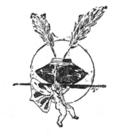
OLD SPANISH ROMANCES
THE HISTORY OF DON QUIXOTE DE LA MANCHA. Translated from the Spanish of Miguel de Cervantes Saavedra by Motteux. With copious Notes (including the Spanish Ballads), and an Essay on the Life and Writings of Cervantes by John G. Lockhart. Preceded by a Short Notice of the Life and Works of Peter Anthony Motteux by Henri Van Laun. Illustrated with Sixteen Original Etchings by R. de Los Rios. Four Volumes.
LAZARILLO DE TORMES. By Don Diego Mendoza. Translated by Thomas Roscoe. And GUZMAN D’ALFARACHE. By Mateo Aleman. Translated by Brady. Illustrated with Eight Original Etchings by R. de Los Rios. Two Volumes.
ASMODEUS. By Le Sage. Translated from the French. Illustrated with Four Original Etchings by R. de Los Rios.
THE BACHELOR OF SALAMANCA. By Le Sage. Translated from the French by James Townsend. Illustrated with Four Original Etchings by R. de Los Rios.
VANILLO GONZALES; or, The Merry Bachelor. By Le Sage. Translated from the French. Illustrated with Four Original Etchings by R. de Los Rios.
THE ADVENTURES OF GIL BLAS OF SANTILLANE. Translated from the French of Le Sage by Tobias Smollett. With Biographical and Critical Notice of Le Sage by George Saintsbury. New Edition, carefully revised. Illustrated with Twelve Original Etchings by R. de Los Rios. Three Volumes.
OLD ENGLISH ROMANCES
THE LIFE AND OPINIONS OF TRISTRAM SHANDY, Gentleman. By Laurence Sterne. In Two Vols. With Eight Etchings by Damman from Original Drawings by Harry Furniss.
THE OLD ENGLISH BARON: A Gothic Story. By Clara Reeve.
ALSO
THE CASTLE OF OTRANTO: A Gothic Story. By Horace Walpole. In One Vol. With Two Portraits and Four Original Drawings by A. H. Tourrier, Etched by Damman.
THE ARABIAN NIGHTS ENTERTAINMENTS. In Four Vols. Carefully Revised and Corrected from the Arabic by Jonathan Scott, LL.D., Oxford. With Nineteen Original Etchings by Ad. Lalauze.
THE HISTORY OF THE CALIPH VATHEK. By Wm. Beckford. With Notes, Critical and Explanatory.
ALSO
RASSELAS, PRINCE OF ABYSSINIA. By Samuel Johnson. In One Vol. With Portrait of Beckford, and Four Original Etchings, designed by A. H. Tourrier, and Etched by Damman.
ROBINSON CRUSOE. By Daniel Defoe. In Two Vols. With Biographical Memoir, Illustrative Notes, and Eight Etchings by M. Mouilleron, and Portrait by L. Flameng.
GULLIVER’S TRAVELS. By Jonathan Swift. With Five Etchings and Portrait by Ad. Lalauze.
A SENTIMENTAL JOURNEY. By Laurence Sterne.
ALSO
A TALE OF A TUB. By Jonathan Swift. In One Vol. With Five Etchings and Portrait by Ed. Hedouin.
SOME PRESS NOTICES.
Daily Telegraph.
“These editions are noteworthy as containing original etchings by artists of high repute. Thus nineteen exquisite plates by the French etcher, M. Lalauze, gives especial attractiveness to the ‘Thousand and One Nights;’ and the two fanciful histories of the Caliph Vathek and Prince Rasselas are illustrated by designs of Mr. A. H. Tourrier, etched by M. Damman. It is a pleasure to hold a ‘Robinson Crusoe’ or the ‘Tale of a Tub’ in one’s hands; it is a positive luxury to read those masterpieces in a luxurious shape, large print, on good paper, accompanied by exquisite illustrations.”
The Scotsman.
“These volumes will take rank, for beauty of typography and general excellence of appearance, with any books of the kind that have recently been published; while the etchings by M. Lalauze are among some of the finest of his productions. They are full of vigour and striking originality, and are what they profess to be—good illustrations of the story to which they relate. There are not many men of wholesome minds who do not find enjoyment in ‘Robinson Crusoe’ whenever they can lay hands on it; and assuredly there is no one possessing anything in the shape of a library who would not desire to have a good edition of the work among his books; in short, nothing but praise can be given to this edition of these books. No one can pretend to be acquainted with English literature who is ignorant of any of the works here published.”
Glasgow Herald.
“The merits of this new issue lie in exquisite clearness of type, completeness; notes and biographical notices, short and pithy, and a number of very fine etchings and portraits. The illustrations of Gulliver are particularly effective, such as the ‘Academy of Laputa’ and the ‘Visions of Glubbdubdrib.’”
London Figaro.
“We congratulate the publishers upon the issue of a capital series of Old English Romances. They will form a most delightful collection.”
Magazine of Art.
“The text of the new four volume edition of the ‘Thousand and One Nights’ is that revised by Jonathan Scott from the French of Galland. It is, in fact, the text in which the incomparable ‘Arabian Nights’ became in England the classic it is. The etchings are uncommonly skilful and finished work; they contain some charming figures; they constitute a true attraction. In another volume of this series Beckford’s wild and gloomy ‘Vathek’ appears side by side with Johnson’s admirable ‘Rasselas.’”
The Literary World.
“A publishers’ notice prefixed to each volume states that ‘one thousand copies of this edition have been printed and the type distributed. No more will be published.’ Although some of these works are now easily obtainable in a cheap form, good editions are rare and eagerly sought by those who make any pretence of making a library. Here is an opportunity of securing as choice an edition as can be desired at a comparatively low price, the value of which will be enhanced before long by its scarcity.”
The Times.
“Prettily printed and prettily illustrated, these attractive volumes deserve their welcome from all students of seventeenth century literature.”
The Daily News.
“The merit for modern readers of these old stories lies partly in their inexhaustible wit, their knowledge of human nature, which never grows stale, and partly in their pictures of the old reckless life of Spain. A typical example of these novels is the fictitious autobiography of Guzman d’Alfarache, the Spanish rogue, written by Matthew Aleman at the beginning of the seventeenth century.”
Daily Telegraph.
“A handy and beautiful edition, in twelve volumes, of the works of the Spanish masters of romance calls for a word of acknowledgment from all who desire to see the lights of foreign literature fitly presented to the notice of English readers. We may say of this edition of the immortal work of Cervantes, that it is most tastefully and admirably executed, and that it is embellished with a series of striking etchings from the pen of the Spanish artist, De Los Rios. . . . Those who have already made acquaintance with these masterpieces of exotic humour will need no encouragement to send them once again to a fountain from which such pure enjoyment is to be derived, and in so acceptable a shape as Messrs. Nimmo & Bain have provided.”
The Scotsman.
“What man of middle age is there, who has been a reader of books, who does not look back with pleasure to his first acquaintance with ‘Don Quixote’ or the ‘Adventures of Gil Blas’? If he has been a wise man of equal mind, he has gone further afield in these romances, and has made acquaintance with ‘Asmodeus,’ ‘The Bachelor of Salamanca,’ and other works of a like kind. They have been read by many thousands of British readers, and they will be read by many thousands more. . . . What the reading public have reason to congratulate themselves upon is, that so neat, compact, and well-arranged an edition of romances that can never die is put within their reach. The publishers have spared no pains with them. It has already been said that Mr. Saintsbury has written a prefatorial notice of Le Sage; a similar work has been done by other hands in the case of Cervantes. It is satisfactory to find publishers turning their attention to the reproduction, in worthy form, of classic fiction; and the hope may be entertained that in this case the enterprise will meet with merited reward.”
Westminster Review.
“We notice with warm welcome a new and very handsome illustrated edition of the original ‘Arabian Nights Entertainment,’ the ‘real Simon pure,’ and never have we seen the fascinating companion of our youth more ‘daintily dight.’ Type and paper are both of the finest quality, while M. Lalauze’s graceful and delicate etchings lend an additional charm to the text. ‘The Thousand and One Nights of Schéhérézade’ occupy four goodly volumes, and uniform with them is Beckford’s ‘Vathek’ and Dr. Johnson’s ‘Rasselas’ in one volume.”
J. C. NIMMO & BAIN,
14, KING WILLIAM STREET, STRAND, LONDON, W.C.

